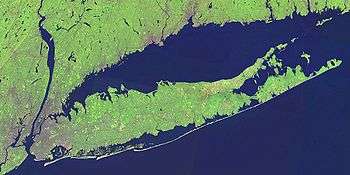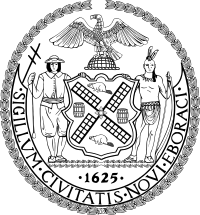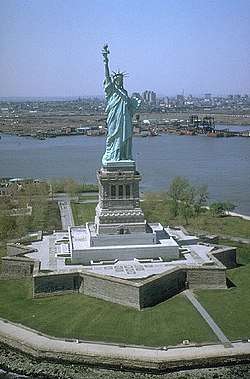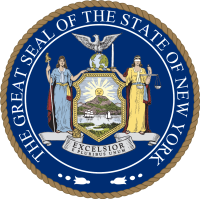Queens
Queens is a borough of New York City, coterminous with Queens County, in the U.S. state of New York. It is the largest borough geographically and is adjacent to the borough of Brooklyn, at the western end of Long Island,[3] and Nassau County to its east. Queens also shares water borders with the boroughs of Manhattan, the Bronx, and Staten Island (via the Rockaways). The borough of Queens is the second-largest in population with an estimated population of 2,253,858 residents in 2019. Approximately 47.5 percent of them are foreign-born.[1] Queens County also is the second-most-populous county in New York, behind Kings County, which is coterminous with Brooklyn. Queens County is the fourth-most-densely populated county among New York City's boroughs, as well as in the United States. If each borough were an independent city, Queens would be the nation's fourth-most populous, after Los Angeles, Chicago, and Brooklyn.[3] Queens is one of the most ethnically diverse counties in the United States, as well as the most diverse among highly populated counties[4][5] and the most linguistically diverse place on Earth.[6]
Queens Queens County, New York | |
|---|---|
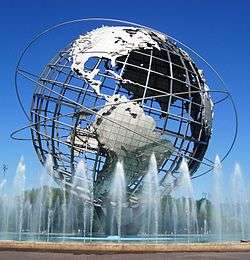 | |
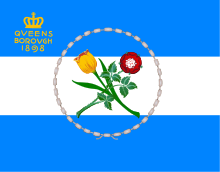 Flag  Seal | |
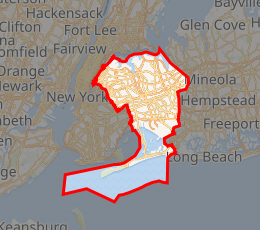
Interactive map outlining Queens | |
| Coordinates: 40°45′N 73°52′W | |
| Country | |
| State | |
| County | Queens (coterminous) |
| City | New York City |
| Settled | 1683 |
| Named for | Catherine of Braganza |
| Government | |
| • Type | Borough (New York City) |
| • Borough President | Sharon Lee (acting) (D) — (Borough of Queens) |
| • District Attorney | Melinda Katz (D) — (Queens County) |
| Area | |
| • Total | 178 sq mi (460 km2) |
| • Land | 109 sq mi (280 km2) |
| • Water | 70 sq mi (200 km2) 39% |
| Population | |
| • Total | 2,230,722 |
| • Estimate (2019)[1] | 2,253,858 |
| • Density | 20,907.4/sq mi (8,072.4/km2) |
| ZIP Code prefixes | 110--, 111--, 113--, 114--, 116-- |
| Area codes | 718/347/929 and 917 |
| GDP (2018) | US$93.3 billion[2] |
| Website | Official Website of the Queens Borough President |
Queens was established in 1683 as one of the original 12 counties of the Province of New York. The settlement was presumably named for the English queen Catherine of Braganza (1638–1705).[7] From 1683 until 1899, the County of Queens included what is now Nassau County. Queens became a borough during the consolidation of New York City in 1898.
Queens has the most diversified economy of the five boroughs of New York City.[8] It is home to John F. Kennedy International Airport and LaGuardia Airport, both among the world's busiest, which makes the airspace above Queens among the busiest in the United States. Landmarks in Queens include Flushing Meadows–Corona Park; Citi Field, home to the New York Mets baseball team; the USTA Billie Jean King National Tennis Center, site of the US Open tennis tournament; Kaufman Astoria Studios; Silvercup Studios; and Aqueduct Racetrack. The borough has diverse housing, ranging from high-rise apartment buildings in the urban areas of western and central Queens, such as Ozone Park, Jackson Heights, Flushing, Astoria, and Long Island City, to somewhat more suburban neighborhoods in the eastern part of the borough, including Douglaston–Little Neck and Bayside.[9][10] The Queens Night Market in Flushing Meadows-Corona Park attracts over 10,000 people nightly to sample food from over 85 countries.[11]
History
Colonial and post-colonial history
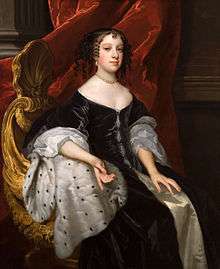
European colonization brought Dutch and English settlers, as a part of the New Netherland colony. First settlements occurred in 1635 followed by early colonizations at Maspeth in 1642 (ultimately unsuccessful),[12] and Vlissingen (now Flushing) in 1645.[13] Other early settlements included Newtown (now Elmhurst) in 1652 and Jamaica in 1655. However, these towns were mostly inhabited by English settlers from New England via eastern Long Island (Suffolk County) subject to Dutch law.[14] After the capture of the colony by the English and its renaming as New York in 1664, the area (and all of Long Island) became known as Yorkshire.
The Flushing Remonstrance signed by colonists in 1657 is considered a precursor to the United States Constitution's provision on freedom of religion in the Bill of Rights. The signers protested the Dutch colonial authorities' persecution of Quakers in what is today the borough of Queens.
| Part of a series of articles on |
|---|
 |
| Topics |
|
| Regions |
|
Originally, Queens County included the adjacent area now comprising Nassau County. It was an original county of New York State, one of twelve created on November 1, 1683.[15] The county is assumed to have been named after Catherine of Braganza, since she was queen of England at the time (she was Portugal's royal princess Catarina daughter of King John IV of Portugal).[7] The county was founded alongside Kings County (Brooklyn, which was named after her husband, King Charles II), and Richmond County (Staten Island, named after his illegitimate son, the 1st Duke of Richmond).[16][17][18] However, the namesake is disputed. While Catherine's title seems the most likely namesake, no historical evidence of official declaration has been found.[19] On October 7, 1691, all counties in the Colony of New York were redefined. Queens gained North and South Brother Islands as well as Huletts Island (today is known as Rikers Island).[20] On December 3, 1768, Queens gained other islands in Long Island Sound that were not already assigned to a county but that did not abut on Westchester County (today's Bronx County).[21]
Queens played a minor role in the American Revolution, as compared to Brooklyn, where the Battle of Long Island was largely fought. Queens, like the rest of what became New York City and Long Island, remained under British occupation after the Battle of Long Island in 1776 and was occupied throughout most of the rest of the Revolutionary War. Under the Quartering Act, British soldiers used, as barracks, the public inns and uninhabited buildings belonging to Queens residents. Even though many residents opposed unannounced quartering, they supported the British crown. The quartering of soldiers in private homes, except in times of war, was banned by the Third Amendment to the United States Constitution. Nathan Hale was captured by the British on the shore of Flushing Bay and hanged in Manhattan.
From 1683 until 1784, Queens County consisted of five towns: Flushing, Hempstead, Jamaica, Newtown, and Oyster Bay. On April 6, 1784, a sixth town, the Town of North Hempstead, was formed through secession by the northern portions of the Town of Hempstead.[22][23] The seat of the county government was located first in Jamaica,[24] but the courthouse was torn down by the British during the American Revolution to use the materials to build barracks.[25] After the war, various buildings in Jamaica temporarily served as courthouse and jail until a new building was erected about 1787 (and later completed) in an area near Mineola (now in Nassau County) known then as Clowesville.[26][27][28][29][30][31][32][33][34][35][36][37][38][39][40][41][42]
The 1850 United States Census was the first in which the population of the three western towns exceeded that of the three eastern towns that are now part of Nassau County. Concerns were raised about the condition and distance of the old courthouse, and several sites were in contention for the construction of a new one.[43]
In 1870, Long Island City split from the Town of Newtown, incorporating itself as a city, consisting of what had been the Village of Astoria and some unincorporated areas within the Town of Newtown. Around 1874, the seat of county government was moved to Long Island City from Mineola.[39][44][45][46]
On March 1, 1860, the eastern border between Queens County (later Nassau County) and Suffolk County was redefined with no discernible change.[47] On June 8, 1881, North Brother Island was transferred to New York County.[48] On May 8, 1884, Rikers Island was transferred to New York County.[49]
In 1886, Lloyd's Neck, which was then part of the town of Oyster Bay and had earlier been known as Queens Village, was set off and separated from Queens County and annexed to the town of Huntington in Suffolk County.[50][51][52] On April 16, 1964, South Brother Island was transferred to Bronx County.[53]
Incorporation as borough
.jpg)
The New York City Borough of Queens was authorized on May 4, 1897, by a vote of the New York State Legislature after an 1894 referendum on consolidation.[54] The eastern 280 square miles (730 km2) of Queens that became Nassau County was partitioned on January 1, 1899.[55]
Queens Borough was established on January 1, 1898.[56][57][58]
"The city of Long Island City, the towns of Newtown, Flushing and Jamaica, and that part of the town of Hempstead, in the county of Queens, which is westerly of a straight line drawn through the middle of the channel between Rockaway Beach and Shelter Island, in the county of Queens, to the Atlantic Ocean" was annexed to New York City,[59] dissolving all former municipal governments (Long Island City, the county government, all towns, and all villages) within the new borough.[60] The areas of Queens County that were not part of the consolidation plan,[45][61][62][63][64][65][66] consisting of the towns of North Hempstead and Oyster Bay, and the major remaining portion of the Town of Hempstead, remained part of Queens County until they seceded to form the new Nassau County on January 1, 1899. At this point, the boundaries of Queens County and the Borough of Queens became coterminous. With consolidation, Jamaica once again became the county seat, though county offices now extend to nearby Kew Gardens also.[67]
In 1899, New York City conducted a land survey to determine the exact border of Queens between the Rockaways and Lawrence. This proved difficult because the border was defined as "middle of the channel between Rockaway Beach and Shelter Island" (now called Long Beach Island), and that particular channel had closed up by 1899. The surveyors had to determine where the channel had been when the consolidation law was written in 1894. The surveyors did so in part by speaking with local fishermen and oystermen who knew the area well.[68]

From 1905 to 1908 the Long Island Rail Road in Queens became electrified. Transportation to and from Manhattan, previously by ferry or via bridges in Brooklyn, opened up with the Queensboro Bridge finished in 1909, and with railway tunnels under the East River in 1910. From 1915 onward, much of Queens was connected to the New York City Subway system.[69][70] With the 1915 construction of the Steinway Tunnel carrying the IRT Flushing Line between Queens and Manhattan, and the robust expansion of the use of the automobile, the population of Queens more than doubled in the 1920s, from 469,042 in 1920 to 1,079,129 in 1930.[71]
In later years, Queens was the site of the 1939 New York World's Fair and the 1964 New York World's Fair. LaGuardia Airport, in northern Queens, opened in 1939. Idlewild Airport, in southern Queens and now called JFK Airport, opened in 1948. American Airlines Flight 587 took off from the latter airport on November 12, 2001, but ended up crashing in Queens' Belle Harbor area, killing 265 people. In late October 2012, much of Queens' Breezy Point area was destroyed by a massive six-alarm fire caused by Hurricane Sandy.
Geography
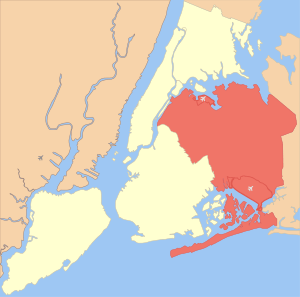
Queens is located on the far western portion of geographic Long Island and includes a few smaller islands, most of which are in Jamaica Bay, forming part of the Gateway National Recreation Area, which in turn is one of the National Parks of New York Harbor.[73] According to the United States Census Bureau, Queens County has a total area of 178 square miles (460 km2), of which 109 square miles (280 km2) is land and 70 square miles (180 km2) (39%) is water.[74]
Brooklyn, the only other New York City borough on geographic Long Island, lies just south and west of Queens, with Newtown Creek, an estuary that flows into the East River, forming part of the border. To the west and north is the East River, across which is Manhattan to the west and The Bronx to the north. Nassau County is east of Queens on Long Island. Staten Island is southwest of Brooklyn, and shares only a 3-mile-long water border (in the Outer Bay) with Queens. North of Queens are Flushing Bay and the Flushing River, connecting to the East River. The East River opens into Long Island Sound. The midsection of Queens is crossed by the Long Island straddling terminal moraine created by the Wisconsin Glacier. The Rockaway Peninsula, the southernmost part of all of Queens, sits between Jamaica Bay and the Atlantic Ocean, featuring 7 miles (11 km) of beaches.[75][76][77]
Boroughscape
Climate
Under the Köppen climate classification, using the 32 °F (0 °C) coldest month (January) isotherm, Queens and the rest of New York City have a humid subtropical climate (Cfa) with partial shielding from the Appalachian Mountains and moderating influences from the Atlantic Ocean. Queens receives precipitation throughout the year, with an average of 44.8 inches (114 cm) per year. In an average year, there will be 44 days with either moderate or heavy rain.[78]
An average winter will have 22 days with some snowfall, of which 9 days have at least 1 inch (2.5 cm) of snowfall.[78] Summer is typically hot, humid, and wet. An average year will have 17 days with a high temperature of 90 °F (32 °C) or warmer.[78] In an average year, there are 14 days where the temperature does not go above 32 °F (0 °C) all day.[78] Spring and autumn can vary from chilly to very warm.
The highest temperature ever recorded at LaGuardia Airport was 107 °F (42 °C) on July 3, 1966.[79][78] The highest temperature ever recorded at John F. Kennedy International Airport was 104 °F (40 °C), also on July 3, 1966.[79][80] LaGuardia Airport's record-low temperature was −7 °F (−22 °C) on February 15, 1943, the effect of which was exacerbated by a shortage of heating oil and coal.[78][81] John F. Kennedy International Airport's record-low temperature was −2 °F (−19 °C), on February 8, 1963, and January 21, 1985.[80][82][83] On January 24, 2016, 30.5 inches (77 cm) of snow fell, which is the record in Queens.[84]
Tornadoes are generally rare; the most recent tornado, an EF0, touched down in College Point on August 3, 2018, causing minor damage.[85] Before that, there was a tornado in Breezy Point on September 8, 2012, which damaged the roofs of some homes,[86] and an EF1 tornado in Flushing on September 26, 2010.[87]
| Monthly and annual statistics for the two main climatology stations in Queens | ||||||||||||||||||||||||||||||||||||||||||||||||||||||||||||||||||||||||||||||||||||||||||||||||||||||||||||||||||||||||||||||||||||||||||||||||||||||||||||||||||||||||||||||||||||||||||||||||||||||||||||||||||||||||||||||||||||||||||||||||||||||||||||||||||||||||||||||||||||||||||||||||||||||||||||||||||||||||||||||||||||||||||||||||||||||||||||||||||||||||||||||||||||||||||||||||||||||||
|---|---|---|---|---|---|---|---|---|---|---|---|---|---|---|---|---|---|---|---|---|---|---|---|---|---|---|---|---|---|---|---|---|---|---|---|---|---|---|---|---|---|---|---|---|---|---|---|---|---|---|---|---|---|---|---|---|---|---|---|---|---|---|---|---|---|---|---|---|---|---|---|---|---|---|---|---|---|---|---|---|---|---|---|---|---|---|---|---|---|---|---|---|---|---|---|---|---|---|---|---|---|---|---|---|---|---|---|---|---|---|---|---|---|---|---|---|---|---|---|---|---|---|---|---|---|---|---|---|---|---|---|---|---|---|---|---|---|---|---|---|---|---|---|---|---|---|---|---|---|---|---|---|---|---|---|---|---|---|---|---|---|---|---|---|---|---|---|---|---|---|---|---|---|---|---|---|---|---|---|---|---|---|---|---|---|---|---|---|---|---|---|---|---|---|---|---|---|---|---|---|---|---|---|---|---|---|---|---|---|---|---|---|---|---|---|---|---|---|---|---|---|---|---|---|---|---|---|---|---|---|---|---|---|---|---|---|---|---|---|---|---|---|---|---|---|---|---|---|---|---|---|---|---|---|---|---|---|---|---|---|---|---|---|---|---|---|---|---|---|---|---|---|---|---|---|---|---|---|---|---|---|---|---|---|---|---|---|---|---|---|---|---|---|---|---|---|---|---|---|---|---|---|---|---|---|---|---|---|---|---|---|---|---|---|---|---|---|---|---|---|---|---|---|---|---|---|---|---|---|---|---|---|---|---|---|---|---|---|---|---|---|---|---|---|---|---|---|---|---|---|---|---|---|---|---|---|---|---|---|---|---|---|---|---|---|---|---|---|---|---|---|---|---|---|---|---|---|---|---|---|---|---|---|---|---|---|---|---|---|---|---|---|
| ||||||||||||||||||||||||||||||||||||||||||||||||||||||||||||||||||||||||||||||||||||||||||||||||||||||||||||||||||||||||||||||||||||||||||||||||||||||||||||||||||||||||||||||||||||||||||||||||||||||||||||||||||||||||||||||||||||||||||||||||||||||||||||||||||||||||||||||||||||||||||||||||||||||||||||||||||||||||||||||||||||||||||||||||||||||||||||||||||||||||||||||||||||||||||||||||||||||||
Neighborhoods
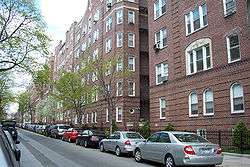
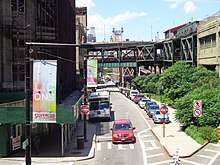
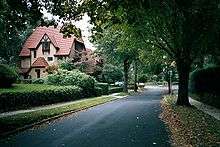
Four United States Postal Service postal zones serve Queens, based roughly on those serving the towns in existence at the consolidation of the five boroughs into New York City: Long Island City (ZIP codes starting with 111), Jamaica (114), Flushing (113), and Far Rockaway (116). Also, the Floral Park post office (110), based in Nassau County, serves a small part of northeastern Queens. Each of these main post offices has neighborhood stations with individual ZIP codes, and unlike the other boroughs, these station names are often used in addressing letters. These ZIP codes do not always reflect traditional neighborhood names and boundaries; "East Elmhurst", for example, was largely coined by the USPS and is not an official community. Most neighborhoods have no solid boundaries. The Forest Hills and Rego Park neighborhoods, for instance, overlap.
Residents of Queens often closely identify with their neighborhood rather than with the borough or city. The borough is a patchwork of dozens of unique neighborhoods, each with its own distinct identity:
- Flushing, one of the largest neighborhoods in Queens, has a large and growing Asian community. The community consists of Chinese, Koreans, and South Asians. Asians have now expanded eastward along the Northern Boulevard axis through Murray Hill, Whitestone, Bayside, Douglaston–Little Neck, and eventually into adjacent Nassau County.[93][94] These neighborhoods historically contained Italian Americans and Greeks, as well as Latino Americans. The busy intersection of Main Street, Kissena Boulevard, and 41st Avenue defines the center of Downtown Flushing and the Flushing Chinatown (法拉盛華埠), known as the "Chinese Times Square" or the "Chinese Manhattan".[95][96] The segment of Main Street between Kissena Boulevard and Roosevelt Avenue, punctuated by the Long Island Rail Road trestle overpass, represents the cultural heart of the Flushing Chinatown. Housing over 30,000 individuals born in China alone, the largest by this metric outside Asia, Flushing has become home to the largest and one of the fastest-growing Chinatowns in the world as the heart of over 250,000 ethnic Chinese in Queens, representing the largest Chinese population of any U.S. municipality other than New York City in total.[97]
- Howard Beach, Whitestone, and Middle Village are home to large Italian American populations.
- Ozone Park and South Ozone Park have large Italian, Hispanic, and Guyanese populations.
- Rockaway Beach has a large Irish American population.
- Astoria, in the northwest, is traditionally home to one of the largest Greek populations outside Greece. It also has large Spanish American, Albanian American, Bosnian American, Bulgarian American, Croatian American, Romanian American and Italian American communities, and is home to a growing population of Arabs, South Asians, and young professionals from Manhattan. Nearby Long Island City is a major commercial center and the home to Queensbridge, the largest housing project in North America.
- Maspeth and Ridgewood are home to many Eastern European immigrants such as Romanian, Polish, Serbian, Albanian, and other Slavic populations. Ridgewood also has a large Hispanic population.
- Jackson Heights which is known as "Little Colombia" thanks to the gastronomical and demographic impact of Colombian people in Queens, specially in this neighborhood,[98] Elmhurst, and East Elmhurst make up a conglomeration of Hispanic, Asian, Tibetan, and South Asian communities.
- Woodside is home to a large Filipino American community and has a "Little Manila" as well a large Irish American population. Many Filipino Americans live in Hollis and Queens Village.
- Richmond Hill, in the south, is often thought of as "Little Guyana" for its large Guyanese community.[99]
- Rego Park, Forest Hills, Kew Gardens, and Kew Gardens Hills have traditionally large Jewish populations (historically from Germany and Eastern Europe; though more recent immigrants are from Israel, Iran, and the former Soviet Union). These neighborhoods are also known for large and growing Asian communities, mainly immigrants from China.
- Jamaica Estates, Jamaica Hills, Hillcrest, Fresh Meadows, and Hollis Hills are also populated with many people of Jewish background. Many Asian families reside in parts of Fresh Meadows as well.
- Jamaica is home to large African American and Caribbean populations. There are also middle-class African American and Caribbean neighborhoods such as Saint Albans, Queens Village, Cambria Heights, Springfield Gardens, Rosedale, Laurelton, and Briarwood along east and southeast Queens.
- Bellerose and Floral Park, originally home to many Irish Americans, is home to a growing South Asian population, predominantly Indian Americans.
- Corona and Corona Heights, once considered the "Little Italy" of Queens, was a predominantly Italian community with a strong African American community in the northern portion of Corona and adjacent East Elmhurst. From the 1920s through the 1960s, Corona remained a close-knit neighborhood. Corona today has the highest concentration of Latinos of any Queens neighborhood, with an increasing Chinese American population, located between Elmhurst and Flushing.[100]
Demographics
| Historical population | |||
|---|---|---|---|
| Census | Pop. | %± | |
| 1790 | 6,159 | — | |
| 1800 | 6,642 | 7.8% | |
| 1810 | 7,444 | 12.1% | |
| 1820 | 8,246 | 10.8% | |
| 1830 | 9,049 | 9.7% | |
| 1840 | 14,480 | 60.0% | |
| 1850 | 18,593 | 28.4% | |
| 1860 | 32,903 | 77.0% | |
| 1870 | 45,468 | 38.2% | |
| 1880 | 56,559 | 24.4% | |
| 1890 | 87,050 | 53.9% | |
| 1900 | 152,999 | 75.8% | |
| 1910 | 284,041 | 85.6% | |
| 1920 | 469,042 | 65.1% | |
| 1930 | 1,079,129 | 130.1% | |
| 1940 | 1,297,634 | 20.2% | |
| 1950 | 1,550,849 | 19.5% | |
| 1960 | 1,809,578 | 16.7% | |
| 1970 | 1,986,473 | 9.8% | |
| 1980 | 1,891,325 | −4.8% | |
| 1990 | 1,951,598 | 3.2% | |
| 2000 | 2,229,379 | 14.2% | |
| 2010 | 2,230,722 | 0.1% | |
| Est. 2019 | 2,253,858 | [1] | 1.0% |
| U.S. Decennial Census[101] 1790-1960[102] 1900-1990[103] 1990-2000[104] 2010-2018[1] | |||
| Racial composition | 2018[105] | 2010[106] | 1990[107] | 1970[107] | 1950[107] |
|---|---|---|---|---|---|
| White | 47.9% | 39.7% | 57.9% | 85.3% | 96.5% |
| —Non-Hispanic | 25.0% | 27.6% | 48.0% | n/a | n/a |
| Black or African American | 20.7% | 19.1% | 21.7% | 13.0% | 3.3% |
| Hispanic or Latino (of any race) | 28.1% | 27.5% | 19.5% | 7.7%[108] | n/a |
| Asian | 26.8% | 22.9% | 12.2% | 1.1% | 0.1% |


2010 U.S. Census
In the 2010 United States Census, Queens recorded a population of 2,230,722. There were 780,117 households enumerated, with an average of 2.82 persons per household. The population density was 20,465.3 inhabitants per square mile (7,966.9/km2). There were 835,127 housing units at an average density of 7,661.7 per square mile (2,982.6/km2). The racial makeup of the county was 39.7% White, 19.1% Black or African American, 0.7% Native American, 22.9% Asian, 0.1% Pacific Islander, 12.9% from other races, and 4.5% from two or more races. 27.5% of the population were Hispanic or Latino of any race. The non-Hispanic/Latino white population was 27.6%.[106]
The New York City Department of City Planning was alarmed by the negligible reported increase in population between 2000 and 2010. Areas with high proportions of immigrants and undocumented aliens are traditionally undercounted for a variety of reasons, often based on a mistrust of government officials or an unwillingness to be identified. In many cases, counts of vacant apartment units did not match data from local surveys and reports from property owners.[109]
2018 estimates
As of 2018, the population of Queens was estimated by the United States Census Bureau to have increased to 2,278,906, a rise of 2.2%. Queens' estimated population represented 27.1% of New York City's population of 8,398,748; 29.6% of Long Island's population of 7,701,172; and 11.7% of New York State's population of 19,542,209. There are 865,878 housing units, and 777,904 households, 2.97 persons per household, and a median value of $481,300. There is an owner-occupancy rate of 44.5.[105]
In Queens, residents consist of 6.2% under 5, 13.9% 6-18, 64.2% 19–64, and 15.7% over 65. Females made up 51.5% of the population. 47.5% of residents are foreign-born.
The per capita income was $28,814, and the median household income was $62,008. 12.2% of residents lived below the poverty line.
Ethnic groups
According to a 2001 Claritas study, Queens was the most diverse county in the United States among counties of 100,000+ population.[110] A 2014 analysis by The Atlantic found Queens County to be the 3rd most racially diverse county-equivalent in the United States—behind Aleutians West Census Area and Aleutians East Borough in Alaska—as well as the most diverse county in New York.[4] Meanwhile, a 2017 study by Axios found that, although numerous smaller counties in the United States had higher rates of diversity, Queens was the United States' most diverse populous county.[5] In Queens, approximately 48.5% of the population was foreign born as of 2010. Within the foreign born population, 49.5% were born in Latin America, 33.5% in Asia, 14.8% in Europe, 1.8% in Africa, and 0.4% in North America. Roughly 2.1% of the population was born in Puerto Rico, a U.S. territory, or abroad to American parents. In addition, 51.2% of the population was born in the United States. Approximately 44.2% of the population over 5 years of age speak English at home; 23.8% speak Spanish at home. Also, 16.8% of the populace speak other Indo-European languages at home. Another 13.5% speak a non-Indo-European Asian language or language of the Pacific Islands at home.[111]
Among the Asian population, people of Chinese ethnicity make up the largest ethnic group at 10.2% of Queens' population, with about 237,484 people; the other East and Southeast Asian groups are: Koreans (2.9%), Filipinos (1.7%), Japanese (0.3%), Thais (0.2%), Vietnamese (0.2%), and Indonesians and Burmese both make up 0.1% of the population.[112] People of South Asian descent make up 7.8% of Queens' population: Indians (5.3%), Bangladeshi (1.5%), Pakistanis (0.7%), and Nepali (0.2%).[112]
Among the Hispanic population, Puerto Ricans make up the largest ethnic group at 4.6%, next to Mexicans, who make up 4.2% of the population, and Dominicans at 3.9%. Central Americans make up 2.4% and are mostly Salvadorans. South Americans constitute 9.6% of Queens's population, mainly of Ecuadorian (4.4%) and Colombian descent (4.2%).[112]
Some main European ancestries in Queens as of 2000 include:
- Italian: 8.4%
- Irish: 5.5%
- German: 3.5%
- Polish: 2.7%
- Russian: 2.3%
- Greek: 2.0%
The Hispanic or Latino population increased by 61% to 597,773 between 1990 and 2006 and now accounts for 26.5% of the borough's population. Queens is now home to hundreds of thousands of Latinos and Hispanics:
- Queens has the largest Colombian population in the city, accounting for 35.6% of the city's total Colombian population, for a total of 145,956.[98]
- Queens has the largest Ecuadorian population in the city, accounting for 62.2% of the city's total Ecuadorian population, for a total of 101,339.
- Queens has the largest Peruvian population in the city, accounting for 69.9% of the city's total Peruvian population, for a total of 30,825.
- Queens has the largest Salvadoran population in the city, accounting for 50.7% of the city for a total population of 25,235.
- The Mexican population in Queens has increased 45.7% to 71,283, the second-highest in the city, after Brooklyn.[113]
Queens is home to 49.6% of the city's Asian population. Among the five boroughs, Queens has the largest population of Chinese, Indian, Korean, Filipino, Bangladeshi and Pakistani Americans. Queens has the largest Asian American population by county outside the Western United States; according to the 2006 American Community Survey, Queens ranks fifth among US counties with 477,772 (21.18%) Asian Americans, behind Los Angeles County, California, Honolulu County, Hawaii, Santa Clara County, California, and Orange County, California.
The borough is also home to one of the highest concentrations of Indian Americans in the nation, with an estimated population of 144,896 in 2014 (6.24% of the 2014 borough population),[114] as well as Pakistani Americans, who number at 15,604.[115] Queens has the second largest Sikh population in the nation after California.[116]
In 2010, Queens held a disproportionate share of several Asian communities within New York City, relative to its overall population, as follows:[117]
- Chinese: 200,205; 39.8% of the city's total Chinese population.
- Indian: 117,550; 64% Asian Indian population.
- Korean: 64,107; 66.4% of the city's total Korean population.
- Filipino: 38,163; 61.3% of the city's total Filipino population.
- Bangladeshi: 18,310; 66% of the city's total Bangladeshi population.
- Pakistani: 10,884; 39.5% of the city's total Pakistani population.
Queens has the third largest Bosnian population in the United States behind only St. Louis and Chicago, numbering more than 15,000.[118]
The Jewish Community Study of New York 2011, sponsored by the UJA-Federation of New York, found that about 9% of Queens residents were Jews.[119] In 2011, there were about 198,000 Jews in Queens, making it home to about 13% of all people in Jewish households in the eight-county area consisting of the Five Boroughs and Westchester, Nassau, and Suffolk counties.[120] Russian-speaking Jews make up 28% of the Jewish population in Queens, the largest in any of the eight counties.[121]
In Queens, the black population earns more than whites on average.[122] Many of these African Americans live in quiet, middle-class suburban neighborhoods near the Nassau County border, such as Laurelton and Cambria Heights which have large black populations whose family income is higher than average. The migration of European Americans from parts of Queens has been long ongoing with departures from Ozone Park, Woodhaven, Bellerose, Floral Park, and Flushing (most of the outgoing population has been replaced with Asian Americans). Neighborhoods such as Whitestone, College Point, North Flushing, Auburndale, Bayside, Middle Village, and Douglaston–Little Neck have not had a substantial exodus of white residents, but have seen an increase of Asian population, mostly Chinese and Korean. Queens has experienced a real estate boom making most of its neighborhoods desirable for people who want to reside near Manhattan but in a less urban setting.
Culture

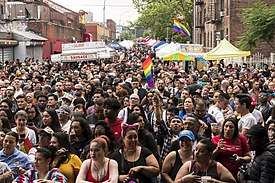
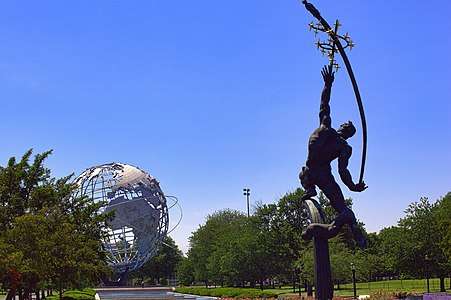
Queens has been the center of the punk rock movement; The Ramones originated out of Forest Hills,[123] it has also been the home of such notable artists as Tony Bennett, Francis Ford Coppola, Paul Simon, and Robert Mapplethorpe. The current poet laureate of Queens is Paolo Javier.[124]
Queens has notably fostered African-American culture, with establishments such as The Afrikan Poetry Theatre[125] and the Black Spectrum Theater Company[126] catering specifically to African Americans in Queens. In the 1940s, Queens was an important center of jazz; such jazz luminaries as Louis Armstrong, Charlie Parker, and Ella Fitzgerald took up residence in Queens, seeking refuge from the segregation they found elsewhere in New York.[127] Additionally, many notable hip-hop acts hail from Queens, including Nas, Run-D.M.C., Kool G Rap, A Tribe Called Quest, LL Cool J, MC Shan, Mobb Deep, 50 Cent, Nicki Minaj, Tony Yayo, Tragedy Khadafi, N.O.R.E., Capone (rapper), Ja Rule, Heems of Das Racist and Action Bronson.
Queens hosts various museums and cultural institutions that serve its diverse communities. They range from the historical (such as the John Bowne House) to the scientific (such as the New York Hall of Science), from conventional art galleries (such as the Noguchi Museum) to unique graffiti exhibits (such as 5 Pointz). Queens's cultural institutions include, but are not limited to:
- 5 Pointz
- Afrikan Poetry Theatre
- Bowne House
- Flushing Town Hall
- King Manor
- MoMA PS1
- Museum of the Moving Image
- Noguchi Museum
- New York Hall of Science
- Queens Botanical Garden
- Queens Museum of Art
- SculptureCenter
- Hindu Temple Society of North America
- Jamaica Center for Arts and Learning
The travel magazine Lonely Planet also named Queens the top destination in the country for 2015 for its cultural and culinary diversity.[128] Stating that Queens is "quickly becoming its hippest" but that "most travelers haven’t clued in… yet,"[129] the Lonely Planet stated that "nowhere is the image of New York as the global melting pot truer than Queens."[130]
Languages
Queens is the most linguistically diverse place on Earth, according to the Endangered Language Alliance.[6] According to the office of the New York State Comptroller, 138 languages are spoken in the borough.[131] As of 2010, 43.84% (905,890) of Queens residents aged five and older spoke only English at home, while 23.88% (493,462) spoke Spanish, 8.06% (166,570) Chinese, 3.44% (71,054) various Indic languages, 2.74% (56,701) Korean, 1.67% (34,596) Russian, 1.56% (32,268) Italian, 1.54% (31,922) Tagalog, 1.53% (31,651) Greek, 1.32% (27,345) French Creole, 1.17% (24,118) Polish, 0.96% (19,868) Hindi, 0.93% (19,262) Urdu, 0.92% (18,931) other Asian languages, 0.80% (16,435) other Indo-European languages, 0.71% (14,685) French, 0.61% (12,505) Arabic, 0.48% (10,008) Serbo-Croatian, and Hebrew was spoken as a main language by 0.46% (9,410) of the population over the age of five. In total, 56.16% (1,160,483) of Queens's population aged five and older spoke a language at home other than English.[132]
Food
The cuisine available in Queens reflects its vast cultural diversity.[133] The cuisine of a particular neighborhood often represents its demographics; for example, Astoria hosts many Greek restaurants, in keeping with its traditionally Greek population.[134] Jackson Heights is known for its prominent Indian cuisine and also many Latin American eateries.
Religion
In 2010 statistics, the largest religious group in Queens was the Diocese of Brooklyn, with 677,520 Catholics worshipping at 100 parishes, followed by an estimated 81,456 Muslims with 57 congregations, 80,000 Orthodox Jews with 110 congregations, 33,325 non-denominational adherents with 129 congregations, 28,085 AME Methodists with 14 congregations, 24,250 Greek Orthodox with 6 congregations, 16,775 Hindus with 18 congregations, 13,989 AoG Pentecostals with 64 congregations, 13,507 Seventh-day Adventists with 45 congregations, and 12,957 Mahayana Buddhists with 26 congregations. Altogether, 49.4% of the population was claimed as members by religious congregations, although members of historically African-American denominations were underrepresented due to incomplete information.[135] In 2014, Queens had 738 religious organizations, the thirteenth most out of all US counties.[136]
Government
| Year | Republican | Democratic | Third parties |
|---|---|---|---|
| 2016 | 21.8% 149,341 | 75.4% 517,220 | 2.9% 19,832 |
| 2012 | 19.9% 118,589 | 79.1% 470,732 | 1.0% 5,924 |
| 2008 | 24.3% 155,221 | 75.1% 480,692 | 0.7% 4,224 |
| 2004 | 27.4% 165,954 | 71.7% 433,835 | 0.9% 5,603 |
| 2000 | 22.0% 122,052 | 75.0% 416,967 | 3.1% 16,972 |
| 1996 | 21.1% 107,650 | 72.9% 372,925 | 6.0% 30,721 |
| 1992 | 28.3% 157,561 | 62.9% 349,520 | 8.8% 48,875 |
| 1988 | 39.7% 217,049 | 59.5% 325,147 | 0.8% 4,533 |
| 1984 | 46.4% 285,477 | 53.3% 328,379 | 0.3% 1,722 |
| 1980 | 44.8% 251,333 | 48.0% 269,147 | 7.2% 40,443 |
| 1976 | 39.0% 244,396 | 60.5% 379,907 | 0.5% 3,200 |
| 1972 | 56.3% 426,015 | 43.4% 328,316 | 0.2% 1,756 |
| 1968 | 40.0% 306,620 | 53.6% 410,546 | 6.4% 48,746 |
| 1964 | 33.6% 274,351 | 66.3% 541,418 | 0.1% 1,059 |
| 1960 | 45.1% 367,688 | 54.7% 446,348 | 0.2% 1,863 |
| 1956 | 59.4% 466,057 | 40.6% 318,723 | 0.0% 0 |
| 1952 | 57.1% 450,610 | 42.0% 331,217 | 0.9% 7,194 |
| 1948 | 50.6% 323,459 | 42.0% 268,742 | 7.4% 47,342 |
| 1944 | 55.3% 365,365 | 44.4% 292,940 | 0.3% 2,071 |
| 1940 | 52.7% 323,406 | 46.9% 288,024 | 0.4% 2,524 |
| 1936 | 33.0% 162,797 | 64.9% 320,053 | 2.1% 10,159 |
| 1932 | 34.3% 136,641 | 61.5% 244,740 | 4.2% 16,760 |
| 1928 | 45.9% 158,505 | 53.4% 184,640 | 0.7% 2,411 |
| 1924 | 53.6% 100,793 | 31.0% 58,402 | 15.4% 28,974 |
| 1920 | 68.7% 94,360 | 25.7% 35,296 | 5.6% 7,668 |
| 1916 | 50.5% 34,670 | 45.7% 31,350 | 3.8% 2,575 |
| 1912 | 16.5% 9,201 | 50.3% 28,076 | 33.2% 18,521 |
| 1908 | 44.1% 19,420 | 46.2% 20,342 | 9.7% 4,246 |
| 1904 | 41.4% 14,096 | 53.4% 18,151 | 5.2% 1,770 |
| 1900 | 43.9% 12,323 | 52.6% 14,747 | 3.5% 976 |
| 1896 | 58.0% 18,694 | 37.2% 11,980 | 4.8% 1,539 |
| 1892 | 41.7% 11,704 | 54.2% 15,195 | 4.1% 1,161 |
| 1888 | 46.0% 11,017 | 52.9% 12,683 | 1.2% 275 |
| 1884 | 43.8% 8,445 | 53.8% 10,367 | 2.4% 471 |
| Party | 2005 | 2004 | 2003 | 2002 | 2001 | 2000 | 1999 | 1998 | 1997 | 1996 |
|---|---|---|---|---|---|---|---|---|---|---|
| Democratic | 62.94% | 62.52 | 62.85 | 62.79 | 62.99 | 62.52 | 62.30 | 62.27 | 62.28 | 62.33 |
| Republican | 14.60% | 14.66 | 14.97 | 15.04 | 15.28 | 15.69 | 16.47 | 16.74 | 16.93 | 17.20 |
| Other | 3.88% | 3.93 | 3.94 | 3.86 | 3.37 | 3.30 | 3.10 | 3.20 | 3.02 | 2.78 |
| No affiliation | 18.58% | 18.89 | 18.24 | 18.31 | 18.36 | 18.49 | 18.13 | 17.79 | 17.77 | 17.69 |
Since New York City's consolidation in 1898, Queens has been governed by the New York City Charter that provides for a strong mayor–council system. The centralized New York City government is responsible for public education, correctional institutions, public safety, recreational facilities, sanitation, water supply, and welfare services in Queens. The Queens Library is governed by a 19-member Board of Trustees, appointed by the Mayor of New York City and the Borough President of Queens.
Since 1990 the Borough President has acted as an advocate for the borough at the mayoral agencies, the City Council, the New York state government, and corporations. Queens' Borough President is Melinda Katz, elected in November 2013 as a Democrat with 80.3% of the vote. Queens Borough Hall is the seat of government and is located in Kew Gardens.
The Democratic Party holds most public offices. Sixty-three percent of registered Queens voters are Democrats. Local party platforms center on affordable housing, education, and economic development. Controversial political issues in Queens include development, noise, and the cost of housing.
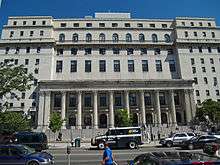
Each of the city's five counties has its criminal court system and District Attorney, the chief public prosecutor who is directly elected by popular vote. Richard A. Brown, who ran on both the Republican and Democratic Party tickets, was the District Attorney of Queens County from 1991–2018. The new DA as of January 2020 is Melinda Katz.[139] Queens has 12 seats on the New York City Council, the second-largest number among the five boroughs. It is divided into 14 community districts, each served by a local Community Board. Community Boards are representative bodies that field complaints and serve as advocates for residents.
Although Queens is heavily Democratic, it is considered a swing county in New York politics. Republican political candidates who do well in Queens usually win citywide or statewide elections. Republicans such as former Mayors Rudolph Giuliani and Michael Bloomberg won majorities in Queens. Republican State Senator Serphin Maltese represented a district in central and southern Queens for twenty years until his defeat in 2008 by Democratic City Councilman Joseph Addabbo. In 2002, Queens voted against incumbent Republican Governor of New York George Pataki in favor of his Democratic opponent, Carl McCall by a slim margin.[140]
On the national level, Queens has not voted for a Republican candidate in a presidential election since 1972, when Queens voters chose Richard Nixon over George McGovern. Since the 1996 presidential election, Democratic presidential candidates have received over 70% of the popular vote in Queens.[141] Since the election of Donald Trump, Queens has become known in the United States for its surge in progressive politics and grassroots campaigning.[142]
Representatives in the U.S. Congress
In 2018, seven Democrats represented Queens in the United States House of Representatives.[143]
- Thomas Suozzi (first elected in 2016) represents New York's 3rd congressional district, which covers the northeast Queens neighborhoods of Little Neck, Whitestone, Glen Oaks, and Floral Park. The district also covers the North Shore of Nassau County.[143]
- Gregory Meeks (first elected in 1998) represents New York's 5th congressional district, which covers the entire Rockaway Peninsula as well as the southeast Queens neighborhoods of Broad Channel, Cambria Heights, Hollis, Jamaica, Laurelton, Queens Village, Rosedale, Saint Albans, Springfield Gardens, and South Ozone Park. The district also includes John F. Kennedy International Airport.[143]
- Grace Meng (first elected in 2012) represents New York's 6th congressional district, which includes the central and eastern Queens neighborhoods of Auburndale, Bayside, Elmhurst, Flushing, Forest Hills, Glendale, Kew Gardens, Maspeth, Middle Village, Murray Hill, and Rego Park.[143]
- Nydia Velázquez (first elected in 1992) represents New York's 7th congressional district, which includes the southwest Queens neighborhoods of Maspeth, Ridgewood, and Woodhaven. The district also covers central and western Brooklyn and the Lower East Side of Manhattan.[143]
- Hakeem Jeffries (first elected in 2012) represents New York's 8th congressional district, which includes the southwest Queens neighborhoods of Ozone Park and Howard Beach. The district also covers central and southern Brooklyn.[143]
- Carolyn Maloney (first elected in 1992) represents New York's 12th congressional district, which includes the western Queens neighborhoods of Astoria, Long Island City, Sunnyside, and Maspeth. The district also covers the East Side of Manhattan.[143]
- Alexandria Ocasio-Cortez (first elected in 2018) represents New York's 14th congressional district, which includes the northwest Queens neighborhoods of Astoria, College Point, Corona, East Elmhurst, Jackson Heights, Woodside, and Elmhurst. The district also covers the East Bronx.[143]
Economy
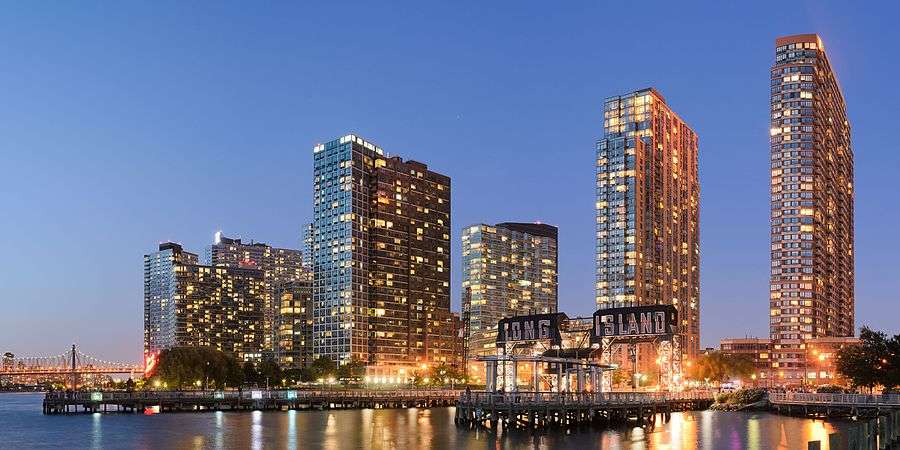
Queens has the second-largest economy of New York City's five boroughs, following Manhattan. In 2004, Queens had 15.2% (440,310) of all private-sector jobs in New York City and 8.8% of private-sector wages. Queens has the most diversified economy of the five boroughs, with occupations spread relatively evenly across the health care, retail trade, manufacturing, construction, transportation, and film and television production sectors, such that no single sector is overwhelmingly dominant.[8]
The diversification in Queens' economy is reflected in a large amount of employment in the export-oriented portions of its economy—such as transportation, manufacturing, and business services—that serve customers outside the region. This accounts for more than 27% of all Queens jobs and offers an average salary of $43,727, 14% greater than that of jobs in the locally oriented sector.
The borough's largest employment sector—trade, transportation, and utilities—accounted for nearly 30% of all jobs in 2004. Queens is home to two of the three major New York City area airports, JFK International Airport and LaGuardia Airport. These airports are among the busiest in the world, leading the airspace above Queens to be the most congested in the country. This airline industry is particularly important to the economy of Queens, providing almost one-quarter of the sector's employment and more than 30% of the sector's wages.
Education and health services are the next largest sector in Queens and comprised almost 24% of the borough's jobs in 2004. The manufacturing and construction industries in Queens are the largest of the city and account for nearly 17% of the borough's private sector jobs. Comprising almost 17% of the jobs in Queens is the information, financial activities, and business and professional services sectors.
As of 2003, Queens had almost 40,000 business establishments. Small businesses act as an important part of the borough's economic vitality with two-thirds of all businesses employing between one and four people.
Several large companies have their headquarters in Queens, including watchmaker Bulova, based in East Elmhurst; internationally renowned piano manufacturer Steinway & Sons in Astoria; Glacéau, the makers of Vitamin Water, headquartered in Whitestone; and JetBlue Airways, an airline based in Long Island City.
Long Island City is a major manufacturing and back-office center. Flushing is a major commercial hub for Chinese American and Korean American businesses, while Jamaica is the major civic and transportation hub for the borough.
Sports
Citi Field is a 41,922-seat stadium opened in April 2009 in Flushing Meadows–Corona Park that is the home ballpark of the New York Mets of Major League Baseball.[145] Shea Stadium, the former home of the Mets and the New York Jets of the National Football League, as well as the temporary home of the New York Yankees and the New York Giants Football Team stood where Citi Field's parking lot is now located, operating from 1964 to 2008.[146]
.jpg)
The US Open tennis tournament has been played since 1978 at the USTA Billie Jean King National Tennis Center, located just south of Citi Field.[147] With a capacity of 23,771, Arthur Ashe Stadium is the biggest tennis stadium in the world.[148] The US Open was formerly played at the West Side Tennis Club in Forest Hills.[149] South Ozone Park is the home of Aqueduct Racetrack, operated by the New York Racing Association and offers Thoroughbred horse-racing from late October/early November through April.[150] Belmont Park Racetrack is mostly in Nassau County, New York however a section of the property including the Belmont Park station on the Long Island Rail Road is in Queens.
Transportation
According to the 2010 Census, 36% of all Queens households did not own a car; the citywide rate is 53%. Therefore, mass transit is also used.[151]
Airports

Queens has crucial importance in international and interstate air traffic, with two of the New York metropolitan area's three major airports located there.
John F. Kennedy International Airport, with 27.4 million international passengers in 2014 (of 53.2 million passengers, overall), is the busiest airport in the United States by international passenger traffic.[152] Owned by the City of New York and managed since 1947 by the Port Authority of New York and New Jersey, the airport's runways and six terminals cover an area of 4,930 acres (2,000 ha) on Jamaica Bay in southeastern Queens.[153] The airport's original official name was New York International Airport, although it was commonly known as Idlewild, with the name changed to Kennedy in December 1963 to honor the recently assassinated president.[154]
LaGuardia Airport is located in Flushing, in northern Queens, on Flushing Bay. Originally opened in 1939, the airport's two runways and four terminals cover 680 acres (280 ha), serving 28.4 million passengers in 2015.[156] In 2014, citing outdated conditions in the airport's terminals, Vice President Joe Biden compared LaGuardia Airport to a "third world country".[157] In 2015, the Port Authority of New York and New Jersey began a $4 billion project to renovate LaGuardia Airport's terminals and entryways. The project is expected to be complete by 2021.[155]
Public transportation
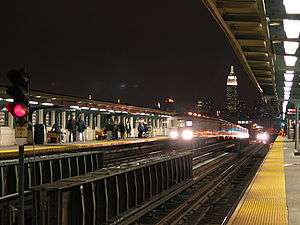
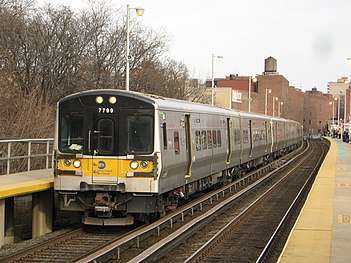
Twelve New York City Subway routes traverse Queens, serving 81 stations on seven main lines. The A, G, J/Z, and M routes connect Queens to Brooklyn without going through Manhattan first. The F, M, N, and R trains connect Queens and Brooklyn via Manhattan, while the E, W, and 7/<7> trains connect Queens to Manhattan only. Trains on the M service go through Queens twice in the same trip; both of its full-length termini, in Middle Village and Forest Hills, are in Queens.[158]
A commuter train system, the Long Island Rail Road, operates 22 stations in Queens with service to Manhattan, Brooklyn, and Long Island. Jamaica station is a hub station where all the lines in the system but one (the Port Washington Branch) converge. It is the busiest commuter rail hub in the United States. There are also several stations where LIRR passengers can transfer to the subway. Sunnyside Yard is used to store Amtrak intercity and NJ Transit commuter trains from Penn Station in Manhattan. The US$11.1 billion East Side Access project, which will bring LIRR trains to Grand Central Terminal in Manhattan, is under construction and is scheduled to open in 2022; this project will create a new train tunnel beneath the East River, connecting Long Island City in Queens with the East Side of Manhattan.[159][160]
The elevated AirTrain people mover system connects JFK International Airport to the New York City Subway and the Long Island Rail Road along the Van Wyck Expressway;[161] a separate AirTrain system is planned alongside the Grand Central Parkway to connect LaGuardia Airport to these transit systems.[162][163] Plans were announced in July 2015 to entirely rebuild LaGuardia Airport itself in a multibillion-dollar project to replace its aging facilities, and this project would accommodate the new AirTrain connection.[155]
About 100 local bus routes operate within Queens, and another 20 express routes shuttle commuters between Queens and Manhattan, under the MTA New York City Bus and MTA Bus brands.[164]
A streetcar line connecting Queens with Brooklyn was proposed by the city in February 2016.[165][166] The planned timeline calls for service to begin around 2024.[167]
Water transit
New York Water Taxi operates service across the East River from Hunters Point in Long Island City to Manhattan at 34th Street and south to Pier 11 at Wall Street. In 2007, limited weekday service was begun between Breezy Point, the westernmost point in the Rockaways, to Pier 11 via the Brooklyn Army Terminal. Summertime weekend service provides service from Lower Manhattan and southwest Brooklyn to the peninsula's Gateway beaches.
In the aftermath of Hurricane Sandy on October 29, 2012, ferry operator SeaStreak began running a city-subsidized ferry service between a makeshift ferry slip at Beach 108th Street and Beach Channel Drive in Rockaway Park and piers in Manhattan and Brooklyn.[168] The service was extended multiple times.[169] finally ending on October 31, 2014.[170]
In February 2015, Mayor Bill de Blasio announced that the city government would begin a citywide ferry service called NYC Ferry to extend ferry transportation to communities in the city that have been traditionally underserved by public transit.[171][172] The ferry opened in May 2017,[173][174] with the Queens neighborhoods of Rockaway and Astoria served by their eponymous routes. A third route, the East River Ferry, serves Hunter's Point South.[175]
Roads
Highways
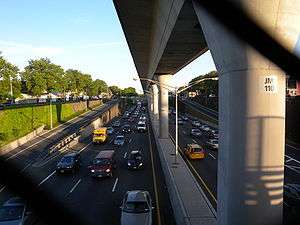
Queens is traversed by three trunk east–west highways. The Long Island Expressway (Interstate 495) runs from the Queens Midtown Tunnel on the west through the borough to Nassau County on the east. The Grand Central Parkway, whose western terminus is the Triborough Bridge, extends east to the Queens/Nassau border, where its name changed to the Northern State Parkway. The Belt Parkway begins at the Gowanus Expressway in Brooklyn, and extends east into Queens, past Aqueduct Racetrack and JFK Airport. On its eastern end at the Queens/Nassau border, it splits into the Southern State Parkway which continues east, and the Cross Island Parkway which turns north.[176]
There are also several major north–south highways in Queens, including the Brooklyn-Queens Expressway (Interstate 278), the Van Wyck Expressway (Interstate 678), the Clearview Expressway (Interstate 295), and the Cross Island Parkway.[176]
Queens has six state highways that run west–east largely on surface roads. From north to south, they are New York State Route 25A (Northern Boulevard), New York State Route 25B (Hillside Avenue), New York State Route 25 (Queens Boulevard, Hillside Avenue, and Braddock Avenue), New York State Route 24 (Hempstead Avenue), and New York State Route 27 (Conduit Avenue). The only state highway that primarily uses an expressway is New York State Route 878, which uses the Nassau Expressway in southern Queens.[176]
Streets
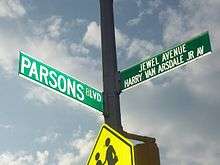
The streets of Queens are laid out in a semi-grid system, with a numerical system of street names (similar to Manhattan and the Bronx). Nearly all roadways oriented north–south are "Streets", while east–west roadways are "Avenues", beginning with the number 1 in the west for Streets and the north for Avenues. In some parts of the borough, several consecutive streets may share numbers (for instance, 72nd Street followed by 72nd Place and 72nd Lane, or 52nd Avenue followed by 52nd Road, 52nd Drive, and 52nd Court), often confusing non-residents.[177] Also, incongruous alignments of street grids, unusual street paths due to geography, or other circumstances often lead to the skipping of numbers (for instance, on Ditmars Boulevard, 70th Street is followed by Hazen Street which is followed by 49th Street). Numbered roads tend to be residential, although numbered commercial streets are not rare. A fair number of streets that were country roads in the 18th and 19th centuries (especially major thoroughfares such as Northern Boulevard, Queens Boulevard, Hillside Avenue, and Jamaica Avenue) carry names rather than numbers, typically though not uniformly called "Boulevards" or "Parkways".
Queens house numbering was designed to provide convenience in locating the address itself; the first half of a number in a Queens address refers to the nearest cross street, the second half refers to the house or lot number from where the street begins from that cross street, followed by the name of the street itself. For example, to find an address in Queens, 14-01 120th Street, one could ascertain from the address structure itself that the listed address is at the intersection of 14th Avenue and 120th Street and that the address must be closest to 14th Avenue rather than 15th Avenue, as it is the first lot on the block. This pattern doesn't stop when a street is named, assuming that there is an existing numbered cross-street. For example, Queens College is situated at 65–30 Kissena Boulevard, and is so named because the cross-street closest to the entrance is 65th Avenue.[177]
Many of the village street grids of Queens had only worded names, some were numbered according to local numbering schemes, and some had a mix of words and numbers. In the early 1920s, a "Philadelphia Plan" was instituted to overlay one numbered system upon the whole borough. The Topographical Bureau, Borough of Queens, worked out the details. Subway stations were only partly renamed, and some, including those along the IRT Flushing Line (7 and <7> trains), now share dual names after the original street names.[178] In 2012, some numbered streets in the Douglaston Hill Historic District were renamed to their original names, with 43rd Avenue becoming Pine Street.[179]
The Rockaway Peninsula does not follow the same system as the rest of the borough and has its own numbering system. Streets are numbered in ascending order heading west from near the Nassau County border, and are prefixed with the word "Beach." Streets at the easternmost end, however, are nearly all named. Bayswater, which is on Jamaica Bay, has its numbered streets prefixed with the word "Bay" rather than "Beach". Another deviation from the norm is Broad Channel; it maintains the north–south numbering progression but uses only the suffix "Road," as well as the prefixes "West" and "East," depending on location relative to Cross Bay Boulevard, the neighborhood's major through street. Broad Channel's streets were a continuation of the mainland Queens grid in the 1950s; formerly the highest-numbered avenue in Queens was 208th Avenue rather than today's 165th Avenue in Howard Beach & Hamilton Beach. The other exception is the neighborhood of Ridgewood, which for the most part shares a grid and house numbering system with the Brooklyn neighborhood of Bushwick. The grid runs east–west from the LIRR Bay Ridge Branch right-of-way to Flushing Avenue; and north–south from Forest Avenue in Ridgewood to Bushwick Avenue in Brooklyn before adjusting to meet up with the Bedford-Stuyvesant grid at Broadway. All streets on the grid have names.
Bridges and tunnels
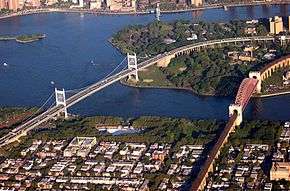
Queens is connected to the Bronx by the Bronx–Whitestone Bridge, the Throgs Neck Bridge, the Triborough Bridge (also known as the Robert F. Kennedy Bridge), and the Hell Gate Bridge. Queens is connected to Manhattan Island by the Triborough Bridge, the Queensboro Bridge, and the Queens–Midtown Tunnel, as well as to Roosevelt Island by the Roosevelt Island Bridge.
While most of the Queens/Brooklyn border is on land, the Kosciuszko Bridge crosses the Newtown Creek connecting Maspeth to Greenpoint, Brooklyn. The Pulaski Bridge connects McGuinness Boulevard in Greenpoint to 11th Street, Jackson Avenue, and Hunters Point Avenue in Long Island City. The J. J. Byrne Memorial Bridge (a.k.a. Greenpoint Avenue Bridge) connects the sections of Greenpoint Avenue in Greenpoint and Long Island City. A lesser bridge connects Grand Avenue in Queens to Grand Street in Brooklyn.
The Cross Bay Veterans Memorial Bridge, built in 1939, traverses Jamaica Bay to connect the Rockaway Peninsula to Broad Channel and the rest of Queens.[180] Constructed in 1937, the Marine Parkway–Gil Hodges Memorial Bridge links Flatbush Avenue, Brooklyn's longest thoroughfare, with Jacob Riis Park and the western end of the Peninsula.[181] Both crossings were built and continue to be operated by what is now known as MTA Bridges and Tunnels. The IND Rockaway Line parallels the Cross Bay, has a mid-bay station at Broad Channel which is just a short walk from the Jamaica Bay Wildlife Refuge, now part of Gateway National Recreation Area and a major stop on the Atlantic Flyway.
Education
Elementary and secondary education
Elementary and secondary school education in Queens is provided by a vast number of public and private institutions. Public schools in the borough are managed by the New York City Department of Education, the largest public school system in the United States. Most private schools are affiliated with or identify themselves with the Roman Catholic or Jewish religious communities. Townsend Harris High School is a Queens public magnet high school for the humanities consistently ranked as among the top 100 high schools in the United States. One of the nine Specialized High Schools in New York City is located in Queens. Located in the York College, City University of New York Campus in Jamaica, the Queens High School for the Sciences at York College, which emphasizes both science and mathematics, ranks as one of the best high schools in both the state and the country. It is one of the smallest Specialized High Schools that requires an entrance exam, the Specialized High Schools Admissions Test. The school has a student body of around 400 students.
Postsecondary institutions
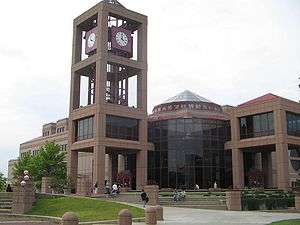
- LaGuardia Community College, part of the City University of New York (CUNY), is known as "The World's Community College" for its diverse international student body representing more than 150 countries and speaking over 100 languages. The college has been named a National Institution of Excellence by the Policy Center on the First Year of College and one of the top three largest community colleges in the United States.[182] The college hosts the LaGuardia and Wagner Archives.
- Queens College is one of the elite colleges in the CUNY system. Established in 1937 to offer a strong liberal arts education to the residents of the borough, Queens College has over 16,000 students including more than 12,000 undergraduates and over 4,000 graduate students. Students from 120 different countries speaking 66 different languages are enrolled at the school, which is located in Flushing. Queens College is also the host of CUNY's law school. The Queens College Campus is also the home of Townsend Harris High School and the Queens College School for Math, Science, and Technology (PS/IS 499).
- Queensborough Community College, originally part of the State University of New York, is in Bayside and is now part of CUNY. It prepares students to attend senior colleges mainly in the CUNY system.
- St. John's University is a private, coeducational Roman Catholic university founded in 1870 by the Vincentian Fathers. With over 19,000 students, St. John's is known for its pharmacy, business and law programs as well as its men's basketball and soccer teams.
- Vaughn College of Aeronautics and Technology is a private, cutting edge, degree-granting institution located across the Grand Central Parkway from LaGuardia Airport. Its presence underscores the importance of aviation to the Queens economy.
- York College is one of CUNY's leading general-purpose liberal arts colleges, granting bachelor's degrees in more than 40 fields, as well as a combined BS/MS degree in Occupational Therapy. Noted for its Health Sciences Programs York College is also home to the Northeast Regional Office of the Food and Drug Administration.
Queens Public Library
The Queens Public Library is the public library system for the borough and one of three library systems serving New York City. Dating back to the foundation of the first Queens library in Flushing in 1858, the Queens Public Library is one of the largest public library systems in the United States. Separate from the New York Public Library, it is composed of 63 branches throughout the borough. In the fiscal year 2001, the Library achieved a circulation of 16.8 million. First, in circulation in New York State since 1985, the Library has maintained the highest circulation of any city library in the country since 1985 and the highest circulation of any library in the nation since 1987. The Library maintains collections in many languages, including Spanish, Chinese, Korean, Russian, Haitian Creole, Polish, and six Indic languages, as well as smaller collections in 19 other languages.
Notable people
Many public figures have grown up or lived in Queens.[183] Musicians raised in the borough include Nas, LL Cool J, A Tribe Called Quest, Mobb Deep, Onyx, Ja Rule, 50 Cent, Lloyd Banks, Tony Yayo, Run–D.M.C., Nicki Minaj, Lil Tecca, Rich The Kid, Tony Yayo , Action Bronson, Nadia Ali[184] and Tony Bennett.[185] Jazz greats Louis Armstrong and Norman Mapp both resided in Corona, as well as rock duo Simon & Garfunkel[186] and guitarists Scott Ian and Johnny Ramone.[187] K-pop rapper Mark Lee from the boy group NCT grew up in Queens before moving to Canada. Actors such as Adrien Brody,[188] and Lucy Liu[189] and Idina Menzel[190] were born or raised in Queens. Actress Mae West also lived in Queens.[191] Writers from Queens include John Guare (The House of Blue Leaves) and Laura Z. Hobson (Gentleman's Agreement). Physician Joshua Prager was born in Whitestone.[192] Mafia boss John Gotti lived in Queens for many years.[193] Richard Feynman, a scientist who was awarded the Nobel Prize in Physics, was born in Queens and grew up in Far Rockaway. Lee "Q" O'Denat, founder of WorldStarHipHop was from Hollis, Queens.
Donald Trump, a businessman who became the 45th President of the United States, was born in Jamaica Hospital Medical Center and raised at 81-15 Wareham Place in Jamaica Estates, later moving to Midland Parkway.[194][195][196] He was preceded in the White House by former First Ladies Nancy Reagan, who lived in Flushing as a child[197] and Barbara Bush, who was born at Booth Memorial Hospital in Flushing.[198] Theodore Roosevelt, the 26th President, lived at Sagamore Hill in Oyster Bay from the mid-1880s until he died;[199] the area was considered part of Queens until the formation of neighboring Nassau County in 1899. Queens has also been home to athletes such as professional basketball player Rafer Alston[200] Basketball players Kareem Abdul-Jabbar[201][202] and Metta World Peace[203][204] were both born in Queens, as was Olympic athlete Bob Beamon.[205] Tennis star John McEnroe[206] was born in Douglaston. Hall of Fame baseball pitcher Whitey Ford grew up in Astoria.[207] Journalist Marie Colvin was a native of Queens.
Queens has also served as a setting for fictional characters, one of the more famous being Peter Parker/Spider-Man from Marvel Comics. The character grew up in Forest Hills with his Aunt May and Uncle Ben.
See also
- List of tallest buildings in Queens
- National Register of Historic Places listings in Queens County, New York
Notes
- Mean monthly maxima and minima (i.e. the expected highest and lowest temperature readings at any point during the year or given month) calculated based on data at said location from 1981 to 2010.
References
- QuickFacts for Queens County (Queens Borough), New York; New York City, New York; United States, United States Census Bureau. Accessed December 17, 2019.
- Local Area Gross Domestic Product, 2018, Bureau of Economic Analysis, released December 12, 2019. Accessed December 17, 2019.
- "Queens". New York State. Retrieved April 27, 2020.
Queens is the easternmost and largest in area of the five boroughs of New York City, geographically adjacent to the borough of Brooklyn
- Narula, Svati Kirsten (April 29, 2014). "The 5 U.S. Counties Where Racial Diversity Is Highest—and Lowest". The Atlantic. Retrieved May 8, 2017.
- "Where America's diversity is increasing the fastest - Axios". Axios. July 3, 2019. Retrieved December 29, 2019.
- Gus Lubin (February 15, 2017). "Queens has more languages than anywhere in the world — here's where they're found". Business Insider. Retrieved December 29, 2019.
There are as many as 800 languages spoken in New York City, and nowhere in the world has more than Queens, according to the Endangered Language Alliance (ELA).
-
- "Queens Almanac". Queens.about.com. November 3, 2009. Retrieved March 28, 2012.
- "Geography: Queens". NY.com. Retrieved March 28, 2012.
- "Queens: Economic Development and the State of the Borough Economy. Report 3-2007" (PDF). Office of the State Comptroller. June 2006. Retrieved March 28, 2012.
- Shaman, Diana (February 8, 2004). "If You're Thinking of Living In/Douglaston, Queens; Timeless City Area, With a Country Feel". The New York Times.
- Hughes, C. J. (November 17, 2011). "Posting – Queens — More Rentals Planned in Long Island City". The New York Times.
- Will Gleason (March 11, 2019). "Citing its diversity and culture, NYC was voted best city in the world in new global survey". TimeOut. Retrieved June 23, 2019.
Just look at the Queens Night Market, which began in the summer of 2015 as a collection of 40 vendors serving authentic and affordable international cuisine in Flushing Meadows Corona Park. Since then, it’s steadily attracted more and more attendees and, last year averaged 10,000 people a night. Those thousands of New Yorkers weren’t just hungry for new food, but for new points-of-view. “When I first started, it was all about how can we attract people with an event that’s as affordable and diverse as possible,” says Night Market founder John Wang. “We’ve now been able to represent over 85 countries, and I’m constantly hearing examples of people branching out and trying things they’ve never heard of before.
- "A Virtual Tour of New Netherland". Archived from the original on September 13, 2012.
- Ellis, Edward Robb (1966). The Epic of New York City. Old Town Books. p. 54.
- Scheltema, Gajus; Westerhuijs, Heleen, eds. (2011). Exploring Historic Dutch New York. New York: Museum of the City of New York/Dover Publications. ISBN 978-0-486-48637-6.
- New York: Commissioners of Statutory Revision:Colonial Laws of New York from the year 1664 to the Revolution, including the Charters of the Duke of York, the Commissions and instructions to Colonial Governors, the Duke's Laws, the Laws of the Dongan and Leisler Assemblies, the Charters of Albany and New York, and the acts of the Colonial Legislatures from 1691 to 1775, inclusive. Report to the Assembly #107, 1894. five Volumes. Albany, New York; 1894–1896; Chapter 4; Section 1; Page 122.
- Room, Adrian (2006). Place Names of the World: Origins and Meanings of the Names for 6,600 Countries, Cities, Territories, Natural Features and Historic Sites. Jefferson, NC: McFarland & Co. p. 308. ISBN 978-0-78642-248-7.
- Antos, Jason D. (2009). Queens. Charleston, SC: Arcadia Publishing. p. 12. ISBN 978-0-73856-308-4.
- Mushabac, Jane; Wigan, Angela (1997). A short and remarkable history of New York City. New York: City & Co. p. 19. ISBN 978-1-88549-250-0.
- Lippincott, E.E. (January 27, 2002). "A Borough President's Goal: Dethroning the Queen of Queens". The New York Times. Retrieved August 3, 2017.
- New York: Commissioners of Statutory Revision:Colonial Laws of New York from the year 1664 to the Revolution, including the Charters of the Duke of York, the Commissions and instructions to Colonial Governors, the Duke's Laws, the Laws of the Dongan and Leisler Assemblies, the Charters of Albany and New York, and the acts of the Colonial Legislatures from 1691 to 1775, inclusive. Report to the Assembly #107, 1894. five Volumes. Albany, New York; 1894–1896; Chapter 17; Section 1; Page 268.
- New York: Commissioners of Statutory Revision:Colonial Laws of New York from the year 1664 to the Revolution, including the Charters of the Duke of York, the Commissions and instructions to Colonial Governors, the Duke's Laws, the Laws of the Dongan and Leisler Assemblies, the Charters of Albany and New York, and the acts of the Colonial Legislatures from 1691 to 1775, inclusive. Report to the Assembly #107, 1894. five volumes. Albany, New York; 1894–1896; Chapter 1376; Section 4; page 1063.
- Greenspan, Walter. "Geographic History of Queens County". Retrieved December 23, 2007.
- French, J. H. (1860). "Towns in Queens County, NY; From: Gazetteer of the State of New York". Archived from the original on January 4, 2013. Retrieved December 28, 2007.
- "Early Five Borough's History". Archived from the original on October 21, 2010. Retrieved December 30, 2007.
When Queens County was created the courts were transferred from Hempstead to Jamaica Village and a County Court was erected. When the building became too small for its purposes and the stone meeting house had been erected, the courts were held for some years in that edifice. Later a new courthouse was erected and used until the seat of justice was removed to North Hempstead.
- McCurdy, John Gilbert (2019). Quarters: The Accommodation of the British Army & the Coming of the American Revolution. Cornell University Press. ISBN 978-1-501-73660-5.
- "Historical Essay: A Thumbnail View". Official History Page of the Queens Borough President's Office. Archived from the original on December 18, 2007. Retrieved December 29, 2007.
From the final withdrawal of the British in November 1783, until the 1830s, Queens continued as an essentially Long Island area of farms and villages. The location of the county government in Mineola (in present-day Nassau County) underscores the island orientation of that era. The population grew hardly at all, increasing only from 5,791 in 1800 to 7,806 in 1830, suggesting that many younger sons moved away, seeking fortunes where land was not yet so fully taken up for farming.
- Peterson, Jon A.; Seyfried, Vincent, eds. (1983). A Research Guide to the History of the Borough of Queens and Its Neighborhood.
- Peterson, Jon A., ed. (1987). A Research Guide to the History of the Borough of Queens, New York City. New York: Queens College, City University of New York.
- "New York – Queens County – History". Retrieved December 29, 2007.
- "History of New York State 1523–1927". The Historical Society of the Courts of the State of New York.
- Sullivan, James (1927). History of New York State 1523–1927. New York, Chicago: Lewis Historical Publishing Company, Inc.
- "New York State History". Genealogy Inc. 1999. Archived from the original on January 8, 2008. Retrieved December 28, 2007.
Under the Reorganization Act of March 7, 1788, New York was divided into 120 towns (not townships), many of which were already in existence.
- "State of New York; Local Government Handbook; 5th Edition" (PDF). January 2000. pp. Ch 4, p 13, Ch 5 p 2. Archived from the original (PDF) on February 15, 2010.
The 1777 New York State Constitution, Article XXXVI, confirmed land grants and municipal charters granted by the English Crown prior to October 14, 1775. Chapter 64 of the Laws of 1788 organized the state into towns and cities...The basic composition of the counties was set in 1788 when the State Legislature divided all of the counties then existing into towns. Towns, of course, were of earlier origin, but in that year they acquired a new legal status as components of the counties.
- "History Mysteries: Shelter Island Ferry/Mineola Building". Archived from the original on July 6, 2008. Retrieved April 1, 2008.
The building shown below "is one of the most important buildings in the history of Mineola," wrote Jack Hehman, president of the Mineola Historical Society. Built in 1787 and known as the "old brig," it was the first Queens County courthouse and later a home for the mentally ill. The building was at Jericho Turnpike and Herricks Road until 1910 when it burned to the ground.
- "The Mineola Asylum; Witnesses who testified that it is and has been a model institution". The New York Times. August 29, 1882. Retrieved April 1, 2008.
The investigation of the charges made against the Superintendent and keepers of the Mineola Asylum for the Insane, which was begun last Tuesday, was continued yesterday by the standing Committee on Insane Asylums of the Queens County Board of Supervisors-- Messrs. Whitney, Brinckerhoff, and Powell. The committee were shown through the asylum, which is the old building of the Queens County Court-house over 100 years old
- Roberts, David. "Nassau County Post Offices 1794–1879". Retrieved April 1, 2008.
- John L. Kay & Chester M. Smith, Jr. (1982). New York Postal History: The Post Offices & First Postmasters from 1775 to 1980. American Philatelic Society.
There was only one post office established in present Nassau County when the Long Island post road to Sag Harbor was established September 25, 1794. It appears that the mail from New York went to Jamaica. This was the only post office in the present-day Boroughs of Queens or Brooklyn before 1803. From Jamaica, the mail went east along the Jericho Turnpike/Middle Country Road route and ended at Sag Harbor. The only post office on this route between Jamaica and Suffolk County was QUEENS established the same date as the others on this route 9/25/1794. This post office was officially Queens, but I have seen the area called "Queens Court House" and was located approximately in the Mineola-Westbury area. The courthouse was used until the 1870s when the county court was moved to Long Island City. Later it served as the Queens County Insane Asylum and still later as an early courthouse for the new Nassau County, during the construction of the present "old" Nassau County Courthouse in Mineola. It was demolished shortly after 1900 ... after about 120 years of service of one type or the other.
- "The Queens County Court-House Question A New Building to be Erected at Mineola". The New York Times. February 25, 1872. Retrieved April 1, 2008.
For forty years the Supervisors of Queens County have been quarreling over a site for a Court-house. The incommodious building used
- Amon, Rhoda. "Mineola: First Farmers, Then Lawyers". Newsday. Archived from the original on October 15, 2008. Retrieved November 11, 2012.
That was the year when the "Old Brig" courthouse was vacated after 90 years of housing lawbreakers. The county court moved from Mineola to Long Island City.
- "Archived copy". Archived from the original on June 10, 2007. Retrieved December 31, 2007.CS1 maint: archived copy as title (link) CS1 maint: unfit url (link)
- The former county courthouse was located northeast of the intersection of Jericho Turnpike (NY Route 25) and the aptly named County Courthouse Road in an unincorporated area of the Town of North Hempstead, variously referred to in the present day as Garden City Park or New Hyde Park. The site is now a shopping center anchored by a supermarket and is located in the New Hyde Park 11040 Zip Code. A stone marker located on the north side of Jericho Turnpike (NY Route 25), between Marcus Avenue and Herricks Road, identifies the site.
- Weidman, Bette S.; Martin, Linda B. (1981). Nassau County, Long Island, in early photographs, 1869–1940. Courier Dover. p. 55. ISBN 9780486241364. Retrieved December 2, 2010.
- "The Queens County Court-House Question" (PDF). The New York Times. February 25, 1872. Retrieved November 11, 2012.
- "A Queens Timeline". The Queens Tribune. Archived from the original on November 9, 2007. Retrieved December 23, 2007.
1874 – Queens County Courthouse and seat of county government moved from Mineola (in present-day Nassau County) to Long Island City.
- Mohan, Geoffrey (2007). "Nassau's Difficult Birth; Eastern factions of Queens win the fight to separate after six decades of wrangling". Newsday. Archived from the original on October 16, 2008. Retrieved November 11, 2012.
North Hempstead, Oyster Bay and the rest of Hempstead were excluded from the vote.
- "The New Queens County Court-House" (PDF). The New York Times. February 9, 1874. Retrieved November 11, 2012.
- New York. Laws of New York; 1860, 83rd Session, Chapter 530, pages 1074—1076.
- New York. Laws of New York; 1881, 104th Session, Chapter 478; Section 1, Page 649.
- New York. Laws of New York; 1884, 107th Session, Chapter 262, page 328.
- (State), New York (1886). Laws of 1886, Chapter 667.
- Beers, F. W. (1873). Atlas of Long Island, New York : from recent and actual surveys and records. New York: Beers, Comstock & Cline.
- "Lloyd Harbor – A Brief History". Incorporated Village of Lloyd Harbor, Suffolk County, NY. Archived from the original on April 27, 2009. Retrieved April 9, 2009.
- New York. Laws of New York; 1964, 187th Session, Chapter 578, page 1606.
- New York. Laws of New York; 1897, 120th Session, Chapter 378; Section 2; Page 2.
- New York. Laws of New York; 1899, 121st Session, Chapter 588; Section 1; Page 1336.
- "Inventing Gotham". Mapsites.net. Archived from the original on July 23, 2011. Retrieved December 28, 2007.
- "Official Announcement of the Results of the Election" (PDF). The New York Times. December 15, 1894. Retrieved December 28, 2007.
The area included a radius of twenty miles (32 km), with the city hall in New York as a center to circumscribe it
- Sullivan, Dr. James, ed. (1927). "Chapter IV, Part VIII". The History of New York State, Book II. Lewis Historical Publishing Company, Inc. Archived from the original on August 22, 2007. Retrieved December 28, 2007 – via US GenNet.org.
- "The Greater New York Charter as enacted in 1897". via Columbia University Libraries. p. 2.
- "Before the Five-Borough City: Queens". bklyn-genealogy-info.com. This map shows the boundaries of the former towns and the former city within the present Borough of Queens.
- "Of Interest to Politicians". The New York Times. September 13, 1894. p. 9. Retrieved December 28, 2007.
The question of the Greater New-York, which is also to be submitted to the people at this coming election, involves the proposition to unite in one city the following cities, counties, and towns: New-York City, Long Island City, in Queens County; the County of Kings, (Brooklyn;) the County of Richmond, (S.I.;) the towns of Flushing, Newtown, Jamaica, in Queens County; the town of Westchester, in Westchester County, and all that portion of the towns of East Chester and Pelham which lies south of a straight line drawn from a point where the northerly line of the City of New-York meets the center line of the Bronx River, to the middle of the channel between Hunter's and Glen Islands, in Long Island Sound, and that part of the town of Hempstead, in Queens County, which is westerly of a straight line drawn from the south-easterly point of the town of Flushing in a straight line to the Atlantic Ocean.
- "Vote for Greater New York". The New York Times. October 16, 1894. Retrieved December 28, 2007.
- "New-York's place in danger; Consolidation defeated, she must yield to Chicago". The New York Times. November 4, 1894. Retrieved December 28, 2007.
- "Greater New-York in doubt; The city vote is for it and Brooklyn is uncertain". The New York Times. November 8, 1894. Retrieved December 28, 2007.
The increase in area and population that New-York will acquire if consolidation becomes a fact will become evident by a glance at the following table... Flushing... *Part of the town of Hempstead... Jamaica... Long Island City ... Newtown... The townships in Queens County that are to be included in the Greater New-York have not been heard from yet...
- "Report favors consolidation.; An Argument Against the Claims of the Resubmissionists". The New York Times. February 22, 1896. p. 1. Retrieved December 28, 2007.
- "The East City Line fixed". The New York Times. February 12, 1899. p. 15. Retrieved December 28, 2007.
- "The Coming Greater City; Benefits to Long Island and Villages under its control". The New York Times. June 7, 1896. p. 16. Retrieved December 23, 2007.
- "The East City Line Fixed: Its Base Found in the Sand of a Closed Beach Channel". The New York Times. February 12, 1899. p. 15.
- Seyfried, Vincent F. & Peterson, Jon A., History Department, Queens College/CUNY. "Historical Essay: A Thumbnail View". Official History Page of the Queens Borough President's Office. Archived from the original on December 18, 2007. Retrieved December 31, 2007.
Even more crucial to future development was the opening of the Queensboro Bridge in 1909. This span ended the isolation of the borough's road system at precisely the time when mass use of the automobile was getting underway in the United States.
CS1 maint: multiple names: authors list (link) - Seyfried, Vincent F. (2004). "A Walk Through Queens with David Hartman and Historian Barry Lewis". Educational Broadcasting Corporation. Retrieved December 29, 2007.
The most momentous event in the history of Queens occurred in 1909 when the long-planned Queensboro Bridge was finally opened. This ended the century-old isolation of the county and dependence on ferries.
- "US Census figures for Queens 1900–1990". U.S. Census Bureau. Archived from the original on March 14, 2007. Retrieved December 7, 2017.
- Willis, Walter I. (1920). Queens Borough New York City, 1910-1920. Chamber Of Commerce of the Borough of Queens.
- "National Parks of New York Harbor - Fact Sheet: Gateway NRA - Jamaica Bay Unit". U.S. National Park Service. Retrieved March 28, 2012.
- "2010 Census Gazetteer Files". United States Census Bureau. August 22, 2012. Archived from the original on May 19, 2014. Retrieved January 7, 2015.
- "Beaches in Queens, New York". Queens.about.com. January 26, 2012. Retrieved March 28, 2012.
- "NYC Beaches 2011". Queens Mamas. May 28, 2011. Archived from the original on March 20, 2012. Retrieved March 28, 2012.
- Perez-Rivas, Manuel (February 22, 1994). "Queens in Albany: Beach Nourished by $$$ Series". Newsday. p. 21.
- "Climatological Report (Annual): LaGuardia NY". National Weather Service. Retrieved August 4, 2018.
- Dallos, Robert E. (July 4, 1966). "Heat Reaches 103, Record for Year: Beaches Jammed". The New York Times. p. 1.
- "Climatological Report (Annual): LaGuardia NY". National Weather Service. Retrieved August 4, 2018.
- "Two Die in Unheated Homes In 8 Below Zero: Snow Due: Suffering in City Is Intense Because of Fuel Shortage—Transport Service Hampered—Slight Relief Today Forecast". The New York Times. February 16, 1943. p. 1.
- "Eastern U.S. Hit by Subzero Cold: Winds Add to the Sharpness of 2 Below in New York". The New York Times. February 9, 1963. p. 4.
- "Upstate Storm Eases: Record Low Hits City". The New York Times. January 21, 1985. p. A10.
- Livingston, Ian (January 25, 2016). "The 12 best meteorological images of the Blizzard of 2016". The Washington Post.
- Cook, Lauren (August 3, 2018). "Tornado touched down in College Point, Queens, NWS says". amNewYork. Newsday.
- Trapasso, Clare; Schapiro, Rich; McShane, Larry (September 9, 2012). "Open House! Queens, B'klyn Become Tornado Alley for Day". New York Daily News. p. 4.
- Schapiro, Rich (September 26, 2010). "Tornado Anxiety: City Twisters Just Coincidence, Experts Say". New York Daily News. p. 22.
- "NowData - NOAA Online Weather Data". National Oceanic and Atmospheric Administration. Retrieved July 22, 2020.
- "Station Name: NY NEW YORK LAGUARDIA AP". National Oceanic and Atmospheric Administration. Retrieved September 11, 2016.
- "NEW YORK/LAGUARDIA ARPT NY Climate Normals 1961−1990". NOAA. Retrieved March 23, 2014.
- "Station Name: NY NEW YORK JFK INTL AP". National Oceanic and Atmospheric Administration. Retrieved September 11, 2016.
- "NEW YORK/JFK, NY Climate Normals 1961−1990". NOAA. Retrieved March 23, 2014.
- Heng Shao (April 10, 2014). "Join The Great Gatsby: Chinese Real Estate Buyers Fan Out To Long Island's North Shore". Forbes. Retrieved April 2, 2016.
- Hymowitz, Carol (October 27, 2014). "One Percenters Drop Six Figures at Long Island Mall". Bloomberg L.P. Retrieved April 2, 2016.
- Haller, Vera (October 1, 2014). "Downtown Flushing: Where Asian Cultures Thrive". The New York Times. Retrieved March 23, 2019.
- Max Falkowitz (August 25, 2018). "A World of Food, Outside the U.S. Open Gates". The New York Times. Retrieved March 23, 2019.
- Melia Robinson (May 27, 2015). "This is what it's like in one of the biggest and fastest-growing Chinatowns in the world". Business Insider. Archived from the original on July 30, 2017. Retrieved March 19, 2019.
- "How Jackson Heights Earned the Nickname 'Little Colombia'". www.ny1.com.
- O'Grady, Jim (January 13, 2002). "Neighborhood Report: Richmond Hill; Making Guyana More Accessible, Two Sisters Start an Airline". The New York Times. Retrieved September 30, 2007.
Many of them live in Richmond Hill. Just as Chinese-Americans energized downtown Flushing, the Guyanese have revived a once-moribund shopping strip on Liberty Avenue between the Van Wyck Expressway and Lefferts Boulevard, now known as Little Guyana.
- McGlinn, Lawrence A., Department of Geography SUNY-New Paltz (2002). "Beyond Chinatown: Dual immigration and the Chinese population of metropolitan New York City" (PDF). Middle States Geographer. Association of American Geographers (35): 110–119. Archived from the original (PDF) on April 2, 2015. Retrieved April 2, 2016.CS1 maint: multiple names: authors list (link)
- "U.S. Decennial Census". U.S. Census Bureau. Retrieved January 7, 2015.
- "Historical Census Browser". University of Virginia Library. Retrieved January 7, 2015.
- "Population of Counties by Decennial Census: 1900 to 1990". U.S. Census Bureau. Retrieved January 7, 2015.
- "Census 2000 PHC-T-4. Ranking Tables for Counties: 1990 and 2000" (PDF). U.S. Census Bureau. Retrieved January 7, 2015.
- "U.S. Census Bureau QuickFacts: Richmond County (Staten Island Borough), New York; Bronx County (Bronx Borough), New York; New York County (Manhattan Borough), New York; Queens County (Queens Borough), New York; Kings County (Brooklyn Borough), New York". www.census.gov. Retrieved October 16, 2019.
- "U.S. Census website". United States Census Bureau. Retrieved May 18, 2019.
- "New York - Race and Hispanic Origin for Selected Cities and Other Places: Earliest Census to 1990". U.S. Census Bureau. Archived from the original on August 12, 2012.
- From 15% sample
- Roberts, Sam (May 24, 2011). "Survey Hints at a Census Undercount in New York City". The New York Times. Retrieved September 12, 2016.
How, they wondered, could Queens have grown by only one-tenth of 1 percent since 2000? How, even with a surge in foreclosures, could the number of vacant apartments have soared by nearly 60 percent in Queens and by 66 percent in Brooklyn?... Often, though, owners of illegally divided houses are reluctant to disclose the number of tenants, who tend to include people who are in the country illegally and are leery of providing any information to the government.
- "Claritas Study Ranks Racial/Ethnic Diversity in Counties Nationwide; Analysis Shows California Leads Nation In Diversity Among Counties Of 100,000-Plus Population". Business Wire. July 23, 2001.
- "Queens County, New York: Selected Social Characteristics in the United States: 2009". U.S. Census Bureau. Archived from the original on January 6, 2012. Retrieved March 28, 2012.
- "2010 Census". U.S. Census Bureau. Archived from the original on February 12, 2020.
- "Quick Demographic Facts for Queens Library Service Areas". Queenslibrary.org. Archived from the original on September 27, 2011.
- "Selected Population Profile in the United States - 2014 American Community Survey 1-Year Estimates Queens County, New York Asian Indian alone". U.S. Census Bureau. Archived from the original on February 14, 2020. Retrieved April 2, 2016.
- "Census Profile: New York City's Pakistani American Population" (PDF). Asian American Federation of New York. December 2004. Archived from the original (PDF) on July 25, 2011.
- Mokha, Kavita (August 20, 2010). "New Immigrants Put Stamp on Richmond Hill". The Wall Street Journal. Retrieved November 9, 2014.
- "Profile of General Population and Housing Characteristics: 2010 - 2010 Demographic Profile Data Queens County, New York". U.S. Census Bureau. Archived from the original on December 25, 2014. Retrieved April 2, 2016.
- Boudreau, Catherine (February 22, 2012). "The Refugee". Quinnipiac Chronicle.
- "Jewish Community Study of New York 2011: Comprehensive Report". UJA-Federation of New York. June 2012. p. 54.
- Jewish Community Study of New York 2011: Comprehensive Report p.49.
- Jewish Community Study of New York 2011: Comprehensive Report p.227.
- Roberts, Sam (October 1, 2006). "Black Incomes Surpass Whites in Queens". The New York Times. Retrieved May 22, 2010.
- "From "Forest Hills: Birthplace of Punk" to "Rock Rock Rockaway Beach"". Queens Museum. Retrieved February 15, 2018.
- "Dia Art Foundation - Events". Diaart.org. March 10, 2011. Retrieved March 28, 2012.
- "History of Afrikan Poetry Theatre". Afrikanpoetrytheatre.org. Archived from the original on February 10, 2012. Retrieved March 28, 2012.
- "About Black Spectrum Theater Company". Blackspectrum.com. December 11, 2010. Archived from the original on May 22, 2012. Retrieved March 28, 2012.
- Virella, Kelly (September 6, 2011). "Best Black Arts & Culture in Queens 2011". Dominion of New York. Retrieved March 28, 2012.
- Rosenberg, Eli; Erikson, Chris (December 11, 2014). "Lonely Planet guidebooks call Queens the best travel destination in the United States". New York Daily News. Retrieved November 25, 2015.
- "Best in the US 2015". Lonely Planet. December 10, 2014.
- "Sutphin Boulevard: The Next Tourist Hot Spot?". NY City Lens. Retrieved April 12, 2016.
- "Queens: An Economic Review". Office of the New York State Comptroller. Archived from the original on February 24, 2012. Retrieved March 28, 2012.
- "Queens County, New York". Modern Language Association. Archived from the original on June 19, 2006. Retrieved August 10, 2013.
- "Eating Out: Guide to Restaurants and Dining in Queens, NY". Queens.about.com. January 5, 2012. Retrieved March 28, 2012.
- "Must-See Astoria: 12 Great Things to See and Do". Nycgo.com. Retrieved March 28, 2012.
- "County Membership Report Queens County (New York)". The Association of Religion Data Archives. 2010. Retrieved January 2, 2020.
- "Social Capital Variables Spreadsheet for 2014". PennState College of Agricultural Sciences, Northeast Regional Center for Rural Development. December 8, 2017. Retrieved December 30, 2019.
- Leip, David. "Dave Leip's Atlas of U.S. Presidential Elections". uselectionatlas.org.
- "Queens Supreme Court". NYC.gov. 2019. Archived from the original on May 2, 2019. Retrieved March 20, 2019.
- "Home". Queens DA.org. Retrieved March 28, 2012.
- "2002 Election Results: Governor and Lieutenant Governor" (PDF). New York State Board of Elections.
- "2000 Election Results: President and Vice President" (PDF). New York State Board of Elections.
- "2004 Election Results: President and Vice President" (PDF). New York State Board of Elections.
- "2008 Election Results: President and Vice President" (PDF). New York State Board of Elections.
- "2012 Election Results: President and Vice President" (PDF). New York State Board of Elections.
- "2016 Election Results: President and Vice President" (PDF). New York State Board of Elections.
- Venugopal, Arun (June 28, 2019). "Why Queens Is the Center of the Nation's Progressive Movement". WNYC. Retrieved June 29, 2019.
Previously known to outsiders as Brooklyn's more-diverse, less-hip neighbor, a vast landscape of ethnic eateries, Queens has emerged as the capitol of the nation's progressive movement.
- "New York Senators, Representatives, and Congressional District Maps". GovTrack.us. May 21, 2018. Retrieved December 29, 2018.
- Henry Goldman (October 30, 2018). "NYC's Fastest-Growing Neighborhood Gets $180 Million Investment". Bloomberg, L.P. Retrieved October 30, 2018.
- "By the Numbers". Citi Field. Retrieved July 5, 2016.
- Schreiber, Jay (April 4, 2009). "Short-Lived, Long-Loved". The New York Times. Retrieved July 5, 2016.
- "National Tennis Center". United States Tennis Association. Retrieved July 5, 2016.
The facility remains completely public, as it has been since the association moved the US Open there from the nearby West Side Tennis Club in Forest Hills in 1978.
- Meyers, Naile-Jean (June 10, 2015). "Supporting Structure for Arthur Ashe Roof Is Completed". The New York Times. Retrieved July 7, 2016.
Zausner said the stadium, the largest in tennis, will maintain its seating capacity of 23,771, though some seats in the highest rows were removed to accommodate two video boards. Seats were added in lower levels to replace those lost, he said.
- Schulz, Dana (August 28, 2017). "A History of the US Open in New York: From the West Side Tennis Club to Arthur Ashe Stadium". 6sqft.com.
- "General Information". Aqueduct Racetrack. Retrieved July 5, 2016.
- "New Yorkers and Cars". New York City Economic Development Corporation. April 5, 2012. Retrieved July 6, 2016.
According to the data, only 1.4 million households in the City out of the total 3.0 million owned a car.... In contrast, a large majority of households in Queens (64%) and particularly in Staten Island (84%) own at least one car.
- U.S. International Air Passenger and Freight Statistics (PDF). International Aviation Developments Series, United States Department of Transportation. December 2014. Retrieved July 6, 2016.
- "Facts and Information". John F. Kennedy International Airport. Retrieved July 6, 2016.
- Reed, Ted (December 20, 2013). "Fifty Years Ago, Idlewild Airport Became JFK". TheStreet.com. Retrieved February 27, 2017.
Fifty years ago on Tuesday, one of the most commonly used words in New York suddenly began to disappear. The word was 'Idlewild,' and it was the name of New York's international airport. On December 24, 1963, the airport's name was changed to John F. Kennedy International Airport, commemorating a young president who had been assassinated just a month earlier.
- McGeehan, Patrick (July 27, 2015). "La Guardia Airport to Be Overhauled by 2021, Cuomo and Biden Say". The New York Times. Retrieved July 6, 2016.
The Port Authority of New York and New Jersey, which operates the airport in northern Queens, estimates the overhaul will cost about $4 billion, most of which will go toward tearing down the Central Terminal Building, rebuilding it in place and augmenting it with a grand entry way.
- "About LaGuardia". LaGuardia Airport. Archived from the original on June 27, 2016. Retrieved July 6, 2016.
- "Biden Compares La Guardia Airport to 'Third World'". The New York Times. Associated Press. February 6, 2014. Retrieved July 6, 2016.
Mr. Biden said that if he blindfolded someone and took him to La Guardia, the person would think he was in 'some third world country.'
- "Subway Map" (PDF). Metropolitan Transportation Authority. October 21, 2019. Retrieved January 18, 2018.
- Siff, Andrew (April 16, 2018). "MTA Megaproject to Cost Almost $1B More Than Prior Estimate". NBC New York. Retrieved November 28, 2018.
- Castillo, Alfonso A. (April 15, 2018). "East Side Access price tag now stands at $11.2B". Newsday. Retrieved November 28, 2018.
- "AirTrain JFK". Port Authority of New York and New Jersey. Retrieved July 6, 2016.
- Durkin, Erin (January 20, 2015). "Andrew Cuomo announces $450M plan to build AirTrain connecting LaGuardia Airport to the subway". New York Daily News. Retrieved January 21, 2015.
- Honan, Katie. "Cuomo Announces AirTrain to LaGuardia Airport from Subway, LIRR". DNAinfo. Archived from the original on January 20, 2015. Retrieved January 20, 2015.
- "Queens Bus Map" (PDF). Metropolitan Transportation Authority. December 2017. Retrieved April 24, 2018.
- Guion, Payton (February 4, 2016). "New York mayor to propose $2.5B streetcar for underserved communities". The Independent. Retrieved February 4, 2016.
- Jorgensen, Jillian (February 4, 2016). "A Streetcar Named Independence: De Blasio Invests in Non-MTA Transit". New York Observer. Retrieved February 5, 2016.
- Grynbaum, Michael M. (February 3, 2016). "Mayor de Blasio to Propose Streetcar Line Linking Brooklyn and Queens". The New York Times. Retrieved February 4, 2016.
- "Seastreak Ferry New Jersey, New York and New Bedford, Martha's Vineyard". Seastreakusa.com. Retrieved April 20, 2014.
- "Rockaway Ferry Floats On Through May, But Trip Will Cost Nearly Double - Rockaway Beach - DNAinfo.com New York". Dnainfo.com. January 20, 2014. Archived from the original on March 30, 2014. Retrieved April 20, 2014.
- http://www.ny1.com/content/news/218228/commuters-bemoan-closing-of-rockaway-ferry/%5B%5D
- McGeehan, Patrick (June 15, 2016). "De Blasio's $325 Million Ferry Push: Rides to 5 Boroughs, at Subway Price". The New York Times. ISSN 0362-4331. Retrieved June 28, 2016.
- "New York City's Ferry Service Set to Launch in 2017". NBC New York. Retrieved May 9, 2016.
- "NYC launches ferry service with Queens, East River routes". New York Daily News. Associated Press. May 1, 2017. Archived from the original on May 1, 2017. Retrieved May 1, 2017.
- Levine, Alexandra S.; Wolfe, Jonathan (May 1, 2017). "New York Today: Our City's New Ferry". The New York Times. ISSN 0362-4331. Retrieved May 1, 2017.
- "Route Map" (PDF). NYC Ferry. 2017. Archived from the original (PDF) on June 28, 2017. Retrieved July 13, 2017.
- Google (January 6, 2017). "Overview Map of Queens" (Map). Google Maps. Google. Retrieved January 6, 2017.
- Kershaw, Sarah (December 15, 2000). "Meet Me At 60th And 60th; Many Drivers Find Streets of Queens A Confusing Maze". The New York Times. Retrieved August 13, 2017.
- Powell, Charles U., Engineer in Charge, Topographical Bureau, Borough of Queens (February 1928). Bringing Order Out of Chaos in Street Naming and House Numbering.
- Nir, Sarah Maslin (March 26, 2012). "In Queens, Taking a Step Back From Numbered Streets". The New York Times. Retrieved March 28, 2012.
- "Cross Bay Veterans Memorial Bridge". MTA Bridges and Tunnels. Retrieved July 5, 2016.
In 1939 the New York City Parkway Authority built the Cross Bay Bridge and Parkway, along with beach improvements in the Rockaways.
- "Marine Parkway–Gil Hodges Memorial Bridge". MTA Bridges and Tunnels. Retrieved July 5, 2016.
The Marine Parkway Gil Hodges Memorial Bridge was opened by the Marine Parkway Authority in 1937 to provide access to the Rockaway Peninsula, which previously could be reached only by ferry or by a circuitous route around the eastern end of Jamaica Bay.
- Top 3 Large Community Colleges in the U.S., Community College Survey of Student Engagement, 2002.
- Ojito, Mirta (September 8, 2001). "Campaigning For City Hall: The Battleground; Gauging the Vote of the Satisfied". The New York Times. Retrieved November 11, 2007.
- "Biography". Nadia Ali.com. Archived from the original on July 14, 2011.
- "Tony Bennett". Biography.com.
- "History of Simon and Garfunkel". Simonandgarfunkel.net. Archived from the original on May 9, 2013. Retrieved April 20, 2014.
Simon and Garfunkel were raised in Forest Hills, and lived within walking distance of one another
- Silverman, Stephen M. (September 16, 2004). "Punk Rock Legend Johnny Ramone Dies at 55". People. Retrieved June 2, 2009.
Johnny Ramone, 55, was born John Cummings and grew up in Forest Hills, N.Y., soaking up rock in the '60s but then moving to an edgier sound.
- "Brody's friend's parents proud". CNN. March 25, 2003. Archived from the original on March 8, 2008.
Brody, who grew up in Woodhaven, and Zarobinski, a native of Rego Park, attended the Fiorello H. LaGuardia High School for Performing Arts together, where Brody studied acting and Zarobinski studied drawing.
- Ogunnaike, Lola (October 13, 2003). "The Perks and Pitfalls Of a Ruthless-Killer Role; Lucy Liu Boosts the Body Count in New Film". The New York Times. Retrieved October 25, 2007.
Born in Jackson Heights, Queens, Ms. Liu, the daughter of working-class Chinese immigrants, recalled many an afternoon spent parked in front of a television set.
- Neumaier, Joe (November 15, 2005). "Rent Control. One part original, one part newcomer". New York Daily News. Retrieved March 17, 2014.
- Blair, Cynthia (2009). "1855: Union Course Tavern, Oldest Bar in Queens, Opens". Newsday. Archived from the original on June 18, 2009.
There is a painting of Mae West, who lived in Woodhaven and performed at the tavern, on the door.
- "From Innovation to Reality" (PDF). North American Neuromodulation Society. December 2012. Archived from the original (PDF) on November 19, 2012.
- "'Dapper Don' John Gotti dead: Brought down by the Bull". CNN.com. June 11, 2002. Archived from the original on July 20, 2013.
- Kellog, Valerie (July 1, 2016). "Donald Trump's boyhood home selling for $1.65M in Queens". Newsday. Retrieved January 17, 2017.
- "Trump's Queens home". Queens Chronicle. March 3, 2016. Retrieved November 4, 2016.
- "See Donald Trump's boyhood neighborhood". CNN. Retrieved April 21, 2016.
- Donachie, Patrick (March 10, 2016). "Flushing neighbor surprised Nancy Reagan lived on block". Times-Ledger.
- "Barbara Bush's legacy had its start in Flushing". Times-Ledger. June 10, 2016.
- "Sagamore Hill National Historic Site". U.S. National Park Service. March 31, 2017. Retrieved September 25, 2017.
- Litsky, Frank (March 25, 1998). "Basketball: N.I.T.; Minnesota Will Meet Penn State for the Title". The New York Times. Retrieved October 18, 2007.
Rafer Alston, the junior point guard from South Jamaica, Queens, explained it this way...
- (born Lew Alcindor)
- "Kareem Abdul-Jabbar". Biography.com.
- (born Ron Artest)
- Aasen, Adam (February 10, 2005). "The man behind the melee". Indiana Daily Student. Archived from the original on April 21, 2014. Retrieved April 20, 2014.
- Williams, Lena (January 1, 2000). "Track and Field; Soothing an Old Ache". The New York Times. Retrieved November 7, 2007.
Neither the outpouring of affection from an adoring public nor the love he finally found after four failed marriages could make up for the neglect and physical abuse he suffered as a child growing up in South Jamaica, Queens.
- "John McEnroe". Biography.com.
- Berkow, Ira (August 17, 2000). "On Baseball; Ford Highlight Film Started Early". The New York Times.
Further reading
- Copquin, Claudia Gryvatz. The Neighborhoods of Queens (Yale University Press, 2007); Guide to 99 neighborhoods
- Glascock, Mary A. An Annotated Bibliography of the History of Queens County, New York (Queens College, 1977) 218 pages
- Lieberman, Janet E., and Richard K. Lieberman. City Limits: A Social History of Queens (Kendall/Hunt Publishing Company, 1983)
- McGovern, Brendan, and John W. Frazier. "Evolving Ethnic Settlements in Queens: Historical and Current Forces Reshaping Human Geography." Focus on Geography (2015) 58#1 pp: 11–26.
- Miyares, Ines M. "From Exclusionary Covenant to Ethnic Hyperdiversity in Jackson Heights, Queens*." Geographical Review (2004) 94#4 pp: 462–483.
- History of Queens County, New York (WW Munsell, 1882)
External links
| Wikimedia Commons has media related to Queens, New York City. |
| Wikivoyage has a travel guide for Queens. |


